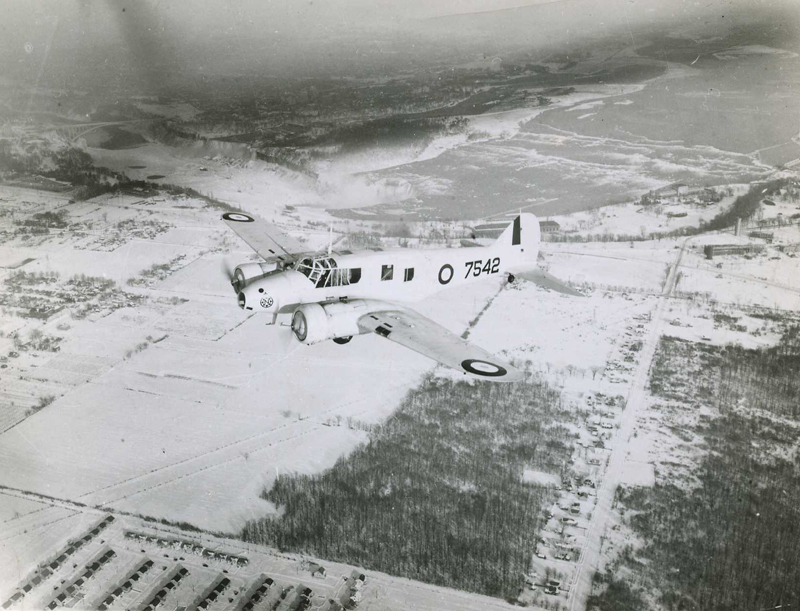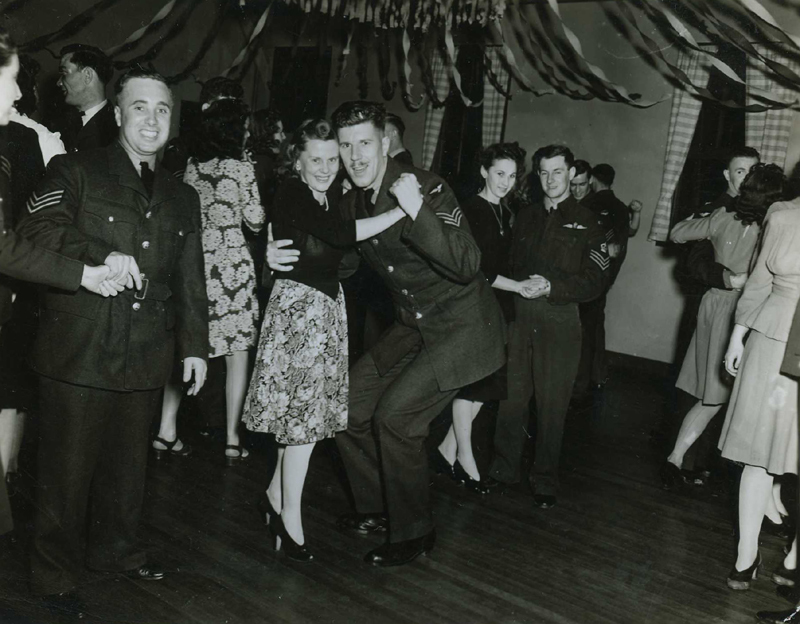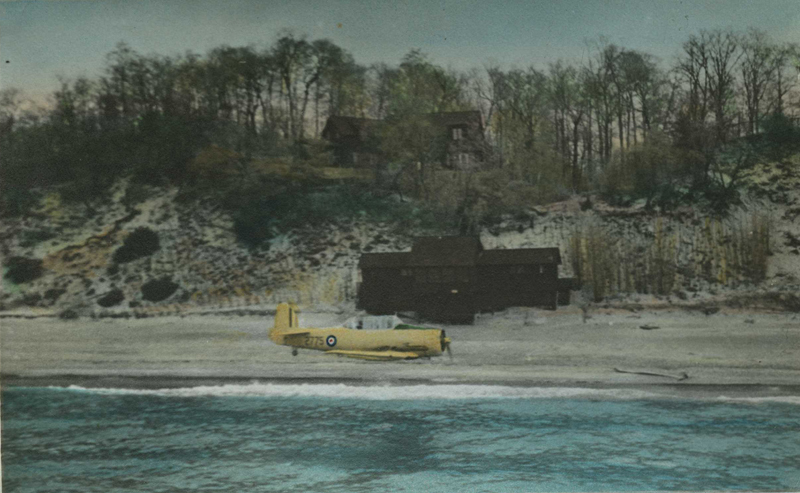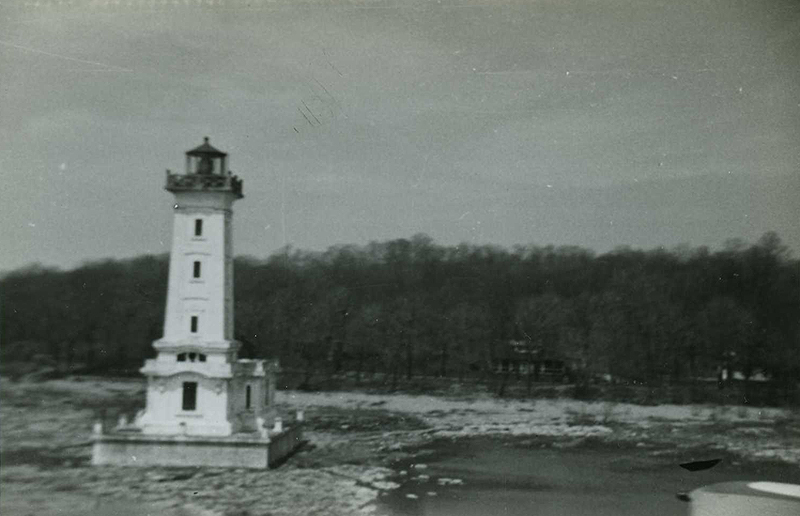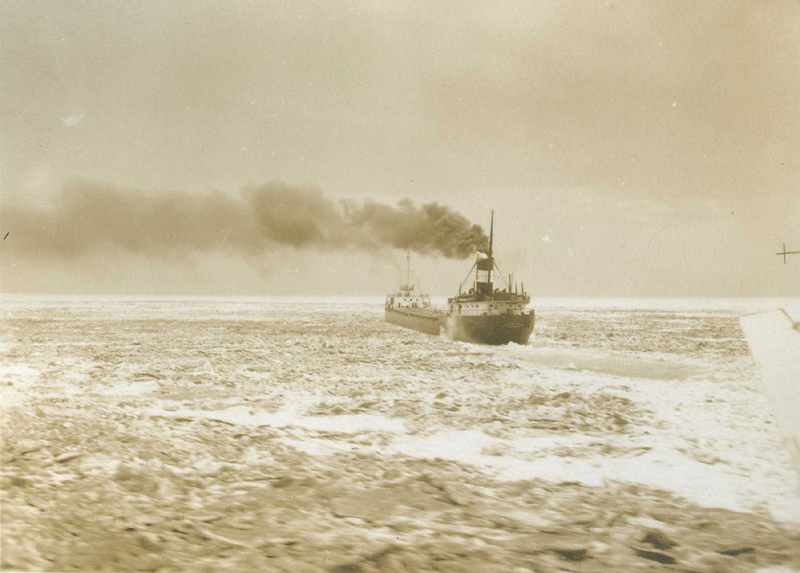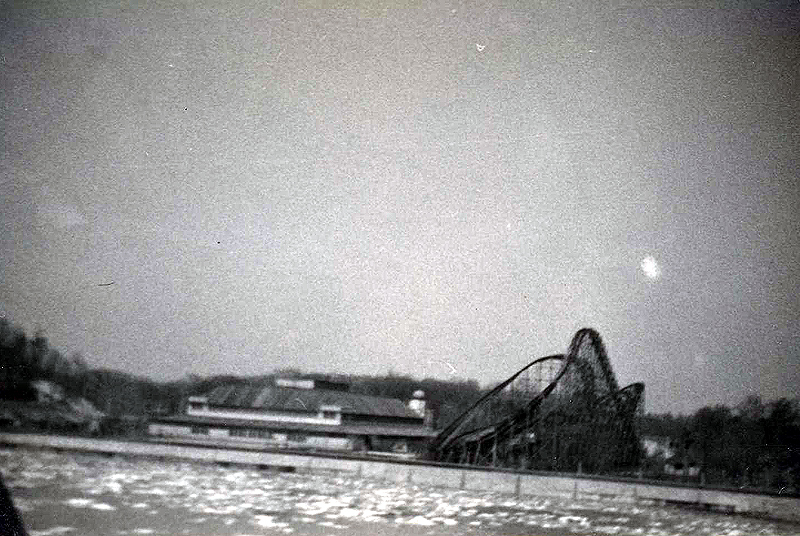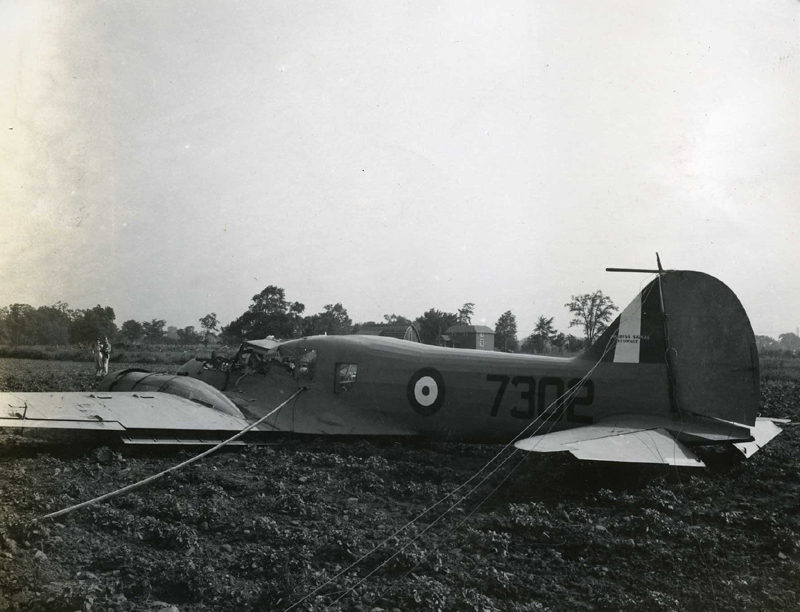Air Force Memories
An Autobiography by Trevor Pearce
Chapter 8
So it's pack the old kit bag and proceed on my way to Dunnville, courtesy of course by the Air Force. Now Dunnville was situated on a peninsular between Toronto and Niagara Falls, about 30 miles from the falls. It lay between Lake Ontario and Lake Erie [the GREAT LAKES]. And what great lakes they were.
Now upon arrival at the new station I reported to the guard house which was a mandatory obligation. This was around 6pm and I was surprised to see some Aussie airmen being locked into the cells by one of their own, so asked the Sergeant in charge what was going on.
“Oh there were about six of them caught doing illegal flying and are being punished, but as there are not enough cells for them so after flying and having the evening meal they take turns at locking one another up for the night. Tomorrow they will swap over.”
It appears that the free ones spend the night in the barracks. What a system. It just goes to show that the Air Force kept the training up while punishing them at the same time .
As I had to report for duty next morning, I was anxious to get a good night's sleep and so nice and early next morning I dressed in my good work clothes and put on my greatcoat and stepped outside. I wont repeat what I said as the wind - straight from the North Pole and not bothering to stop for anything - hit me. My teeth started to chatter like there was no tomorrow, so I went back inside to put on more clothes if I could find any and set forth again for the hangar.
On reporting to the flight commander, Flight Lieutenant Yule - a Canadian and still in his twenties - I was welcomed and introduced to other members of my unit. There certainly was a mixture of nationalities; Benny Rhul from Louisiana; ”Pop” Corn from South Carolina; Dick Sable from Chicago; (these three being USA residents who elected to join the RCAF early on in the piece); George Tuttle from the UK volunteer reserve and the rest Canadian.
Now it was time to meet the aircraft that I would be flying. These being Avro Anson's Mk II. Now these were different from the Mk I's in that they had most of the windows altered and also had a molded plywood nose plus the engines were Jacobs L6MB's. Their undercarriage retraction system was Hydraulic, operated via a plunger on the floor to the right of the pilot. Also they were equipped with one of the first disk brakes but without a booster to assist them and they caused no end of trouble, of which more later. Electric starters were fitted compared to the hand wound ones on the Mk I's but as far as handling was concerned there didn't appear to be much difference. They still went down at the rate of 50ft a minute on one motor.
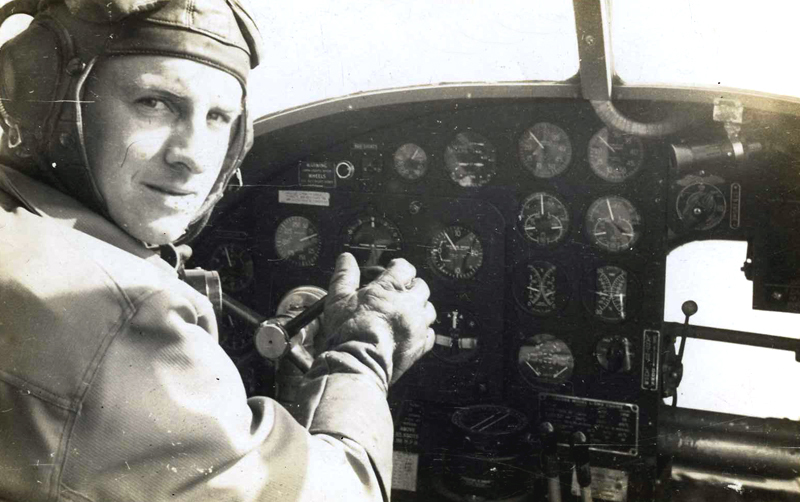
Trevor at the controls of an Anson Mk II
So having had a check flight I was cleared to fly and was given my assignment and that was to take the Harvard trainee pilots on their navigation exercises but and it was emphasized most emphatically was not to assist them in any way - just follow their instructions - but if they got lost or we were running into difficulties then we were to take over and get them home where they would be assessed. Also some of my chores was to take visiting dignitaries on sightseeing trips over the Welland Canal, then to Niagara Falls and a general tour of the countryside. I was also required to take, not necessarily together, the paymaster, the padre, the security head, the doctor and the dentist in other words act as a general carrier. These last were taken at various times to the other stations.
To add excitement we would be asked to ferry aircraft up to Rock Field, Ottawa, for movement on to other stations by the regular ferry pilots. Why we had the honour to ferry these aircraft was because when the Anson's came from the factory they could be stored on our field until required and there was row upon row of them when I first arrived.
Now it was a known fact that if you had a 48 hour pass and wanted to go to Ottawa you only had to ask if there was an aircraft to deliver; and if there was one, you had the pleasure of flying it up to Rock Field then going on leave. And because you had to get home you were issued with a train pass and so you had the best of both worlds as far as leave was concerned with all travel expenses paid for by the government. However if there was a lot of aircraft to be delivered then you flew up as a group and returned via an aircraft sent up to bring you home.
Not long after my arrival I was detailed to take one aircraft to Ottawa along with four others to be delivered by other pilots. So a leader was appointed and I assumed that we would fly in loose formation, but oh no, the boys had other ideas. As I was the new kid on the block I was relegated to tail end Charlie and so after picking up the relevant aircraft papers, away we went flying loosely up to Welland Canal then across Lake Ontario to get on the MAIN land. Now the fun started, the designated leader going down as low as he could and everyone else lining up behind him. Then as we came across a line of high tension lines leading up to Ottawa, the leader flew under the wires so we all one after another did the same [naturally]. He then missed one pylon and flew round the next turning left and so on - first to the left, then the right, missing every second pylon all the way up to the outskirts of Ottawa where about six miles out we pulled up to 1000ft and flew on to the airfield!
Now it was standard practice to join a circuit to check the wind and anything that might hamper you landing, but we just flew straight in after lowering our undercarriage and flaps as apparently our leader knew which runway would be in use, and also this was not a training station and so we did not have to worry about stupid trainees doing stupid things in the circuit. No. this was a station concerned with ferrying aircraft to other stations across the width of Canada/ Now the aircraft that I had to ferry was unique in that it was the only one in the whole bunch that was fitted with variable speed propellers and indeed all the Anson's I saw in Canada I never saw another one fitted with v/p props, but it just goes to show you what the Air Force expected of you. Just fly the cotton picking thing and don't ask any questions.
So all we had to do now was wait for our taxi aircraft to arrive and take us home.
“I hope its not 7302," one of the pilots said.
“Why?” I asked
“Because we won't get home." was his reply. "'02 always breaks down.“ At that point in time an aircraft showed up on finals, wheels and flaps down so it must be our taxi, but what's this? '7302' is on the side of the aircraft so it looks as if we are in for an interesting ride home.
Climbing in, we settled down for the trip home, and so off we go. When approximately opposite our base, but still on the mainland, we turned for home over the water and about ten minutes into the flight over the water there came a horrible sound from the port motor. The pilot had no option but to turn back towards Trenton and hope we would make land. So this was going to be my third forced landing.
Now on the way to land it was apparent that we would make land but not at the land height for there was a cliff in front of us. On top of the cliff was a field at the end of the field a fence, then a main road [the road from Ottawa to Toronto], another fence then Trenton airfield. But the field was above us so at the last moment with a mighty heave and much praying by one and all the pilot, one F/O Stevens, pulled the aircraft up virtually to a stalling point then pushed hard on the stick pulled the throttle back and the aircraft sank onto the ground oh so beautifully. And of course the airfield was tantalizingly close but we were not going there - at least not by aircraft. It was just a short walk over to the field to report our arrival. Imagine the look on the air controller when he asked where our aircraft was.
”Just over in the next paddock,” was the pilots reply. You must realise that the controller didn't know we were arriving as we had no radio to tell him, and our original flight plan took us to the North of his field. So we got it to the field, now it's up to Trenton Air Force to get the aircraft over the road and repaired. Not our problem.
However we were obliged to spend the night at Trenton before an aircraft from Dunnville arrived to take us all home. Now remember that there were five of us with our parachutes plus of course the pilot of the relief aircraft, so we had a pretty well loaded aircraft. Now the journey took 1 hour 25 minutes for the journey. This included about 40 minutes over the lake so you can see that the lake was pretty large and we flew over the bottom end past Hamilton [no not our Hamilton here in NZ] on to our airfield. Now the pilot of our relief was P/O Tull from England, a Volunteer reservist all of 20 years old and one hell of a nice guy.
A Harvard low over the lake
On this station we had, for the trainees, Harvards and an aircraft called a Yale. It was very similar to a Harvard but with differences such as a fixed undercarriage hand wound starter, hand wound flaps, motor much smaller and the panels would not interchange. Also if my memory serves me [just a minute while it comes back from outside] a v/p prop fitted. These aircraft were originally for the French and so the instruments were all in French except the altimeter which they had converted to English speaking one but for everything else they painted Red, Green or Yellow lines on the dials and you were not permitted to do aerobatics.
So after a conference with one of the instructors we came to a mutual agreement and that was for him getting me time on a Harvard, and I would show him how to fly an Anson. This of course was not to the higher ups liking but they turned a blind eye providing it did not interfere with their programme. So let the games begin.
Now the Yales had been held back from delivery to France because of the fall of France, so rather than waste them they decided to use them for mundane training and slowly get rid of them. So here was a perfect opportunity to fly single engine aircraft again. There was a policy in the Royal Canadian Air Force that one could have 2hrs of private flying time a month to do with how you wanted to. Of course in the Anson you could not do aerobatics [officially] so here was an opportunity to go solo on a Harvard and let off steam to ones heart content.
One thing that the Air Force did and that was if you showed any initiative PROVIDING THAT IT WASN'T SOMETHING STUPID they were loath to stop you, as who knows, one day you could be of some use to them in some other capacity. So when time allowed and there was an aircraft available I eventually got checked out on a Yale and so got some hours up and then when a Harvard became available I got checked out on the Harvard. Wow! Now I'm cooking. I now have nine columns of my log book filled and only have one more to go to get all columns filled, but the last one [single engine solo at night] was to elude me for some time to come.
But now with authority to fly single engines I grabbed one, be it a Yale or Harvard, and flew all over the place . Eventually the Yales were taken out of service so all flights were then done in Harvard's. Wacko. Now I could vent my frustrations out on the aircraft. As we were not supposed to acrobat the Anson [but did] it was a pleasure to do spins, loop the loop, rolls off the top, rolls etc, just to let off steam. Of course not all of the navigation boys wanted to fly singles but that was their hard luck I was happy.
Now we, the navigation flight, were expected to fly in all types of weather, even if flying was canceled for the the trainees and this produced some hair raising tales. On one of my flights I had, as was usual. two pupils - one being an American [don't hold that against him] who asked me if he could smoke. This was theoretically not allowed in the aircraft but it happened. So feeling generous in the extreme I agreed to let him light up. One thing that I did not like was the smell of cigar smoke and guess what he lit up. Yup one dirty big cigar.
Oh well, I can fly with my window open and get rid of the smell. Well as the exercise went on it became very apparent that neither of these bods knew how to navigate but I'll just let them go on for a little while longer. And the further we went the more we got lost. The cigar smoking hombre kept giving me a change of course every few minutes so I thought that now was the time to step in and take them home.
“Sit down, take that bloody cigar out of your mouth and throw it overboard and I'll take you home “
Of course I did not tell them that I was also lost. You see normally I used to carry a map of the route we would take and so I would know exactly where we were but for some unknown reason on this trip I failed to do so. So you can see how a pilot can get so lax especially us staff pilots. It hasn't taken long to get up to the big boys standard has it.
So now we have a dilemma - they don't know where we are and neither do I, so I had better show them how to find the way home without them knowing the truth. Well I saw through a gap in the clouds a railway station so promptly dove down to have a look at the name on the side. But as we were close to the East coast and the powers that be were worried that the names could be used by the enemy for positioning, the name boards were all removed so without any more ado I turned the aircraft onto a heading I knew would get me to Toronto and from there I would have no trouble getting home.
But fate was against me and when I thought that I should have been at Toronto NOTHING as the cloud cover was what we called 10/10ths so what to do? Ah well, there is more than one way to kill a cat and so I turned in the direction of Lake Erie and guessed that if I flew long enough over the lake I would find a clear spot and could get home from there even though I would be over American territory
But at that precise moment above the clouds there appeared an ominous black cloud and then another three followed it. Yippee I know exactly where we are. We're over the no fly zone at Hamilton. So a quick turn to port and the nose of the aircraft pushed hard down I got to hell out of there, because on the wall of our flight room was a large map of our area and in one corner of the map was a red and yellow diagonal marked as a no fly zone. We had been warned that IF we flew over this area we would be fired at and make no mistake about that.
So from this stage on, I knew we were as good as home. On landing I thought it wise not to inform the students that I too was lost. Just let that be a lesson to them on how to find your way home. Yes I still have a photo of that map with me laying on the desk below it on one of the washout days.
Stooging along in an Anson
When these days occurred it was common practice of grabbing what was available for laying on, so it was possible to find bods all over the place having a snooze [see photo]. As you know, flying in conditions that had to be seen to be believed was very taxing on ones system. We were not fine weather fliers.
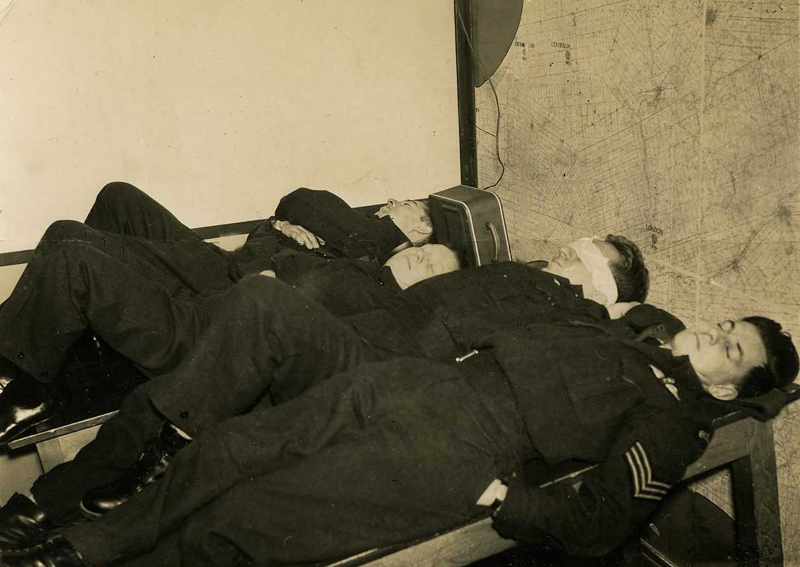
A washout day. Note the map on the wall.
On October 15th, 1942, “Pop” Corn and myself plus a hanger-on went up to do some mutual instrument flying, well at least that was the intention. I was the 1st pilot with Pop to do the instrument flying but on the way down the runway tail up and just on the point of getting airborne there was a terrific vibration from the aircraft so as we were at take off speed and no room to stop I heaved it off the ground and then all vibrations stopped as I had retracted the undercarriage
“What would you do if you had a blown tire?” Pop asked.
“Well the first thing I would do is notify the tower by beating the hell out of it," I answered.
“Good oh then, lets do it because that's what you have.” So with those words we, and I mean we, proceeded to attack the tower with gay abandon, getting as close and as low as possible, raising and lowering the undercarriage in succession until the boys in the tower decided that the tower offered no shelter from the attacking plane. After we had decided that by now they must know that something was wrong we proceeded to land.
Now as we had the dual controls hooked up we knew that if we could do a precautionary landing on the grass we might not do much damage. So dragging the tail of the aircraft along the grass with the nose at a high angle of attack, throttles wide open, we proceeded across the field until near the edge of the grass prior to cutting the motors and both of us pulling hard on the sticks. I cut the throttles and we dropped to the ground with no damage.
Now on reporting to the tower they wanted to know, "What the hell did you two buggers think you were doing?”
"Just showing you that we had problems with the undercarriage.”
“Do you think that we didn't see the tire blow?” was their reply.
“We're not mind readers, Sir.” Just take notice how polite I was, knowing full well that there was not a damn thing they could do to me. But we did have fun for a while. And apparently we also had the whole station out looking at us.
In November 1942 we were blessed with a Coca Cola revue party and as was customary, all Officers sat at the front, followed by the NCO's and then the men. So of course I am up amongst the elite. The revue as such was a great success until the last item, which just happened to be a Latin American dance and volunteers were asked to come on up to the stage to participate. Well one minute I am enjoying the show and next I find that I am on my way to the stage by kind help from my so-called mates.
I was not amused, as I tried to walk off the stage gracefully I might add, but oh no the revue staff were not having that and held onto me just so the station photographer could take a picture so I just had to participate.
Normally the cast of any concert party go afterwards to participate of refreshments etc to the officers mess but the CO had ordered that the party was to be held at the NCO's mess, bless him, and so I got to talking to the cast and discovered that my landing on the stage had been arranged beforehand and that is why the photographer just happened to be in the right spot at the right time. And I still have the photos to show for it.
Now Christmas was arriving and we in the navigation section knew that we would only be getting a few days off and so had to make early arrangements for leave. Me having no home so to speak would have to spend the time at the base but fortunately for me Dick Sable, the American, asked me if I would like to go down to his place in Chicago and spend a few days - three to be exact - with his family. You were not allowed to go and stay in the mighty U.S. of A unless you had what was called a short H pass or someone would vouch for you, so as Dick was an American citizen we were away to the city of the gangsters.
Well I must say that the hospitality was overwhelming as I was welcomed in with open arms and on Christmas morning there was even a present for me, a beautiful leather wallet. Not knowing the drill so to speak I of course had not bought anything for them but was made to feel right at home. Now to celebrate Xmas, Dick took me to a well known night club but at the entrance I was told that I was too young to enter. Dick just pulled himself up to his full height of 6ft plus and said in his loudest voice,
“What, would you deny a Battle of Britain pilot entrance?”
Next minute a fine figure of a manager presents himself in front of us and invited us in, taking us up to the best table he could offer, then calling the girl in the skimpy outfit over to us told her that she was to get us anything we wanted and there would be no charge, “and have a pleasant evening to you both.”
WOW, what a reception and I hadn't said a thing. WE had drinks supplied not by the management but by the other patrons. Also all the food we wanted and I was even given a red rose. I don't know what they thought I was but I accepted it gracefully and took it home and gave it to Dick's mother. Why no-one asked me about the battle I do not know, but we got through the night's entertainment with even the dancers dancing around the table. How could you spoil a night like this after all I was a hero in someone’s eyes, wasn't I?
So on the third day there, Dick took me for a sightseeing tour around town and one place I did want to see was THE GHETTO that I had heard so much about. Now the Ghetto was something to see. I just could not believe people lived like this. The filth was terrific and one did not step down from the curb but rather up onto the accumulated muck. I was horrified, meat was on open display with the accompanying flies buzzing around. Now I was after a pistol, small enough to fit into my flying boots so we went hunting for one. On approaching one likely looking character he told us that he had nothing but come inside the shop.
“What you want we got, but no guns.” However his persistence eventually paid off and we entered the store. On entering he promptly produced a tray of guns and one took my fancy, a nice little Colt automatic .25 calibre. The price was good but I would have to get a permit for it so off to the police station to see if I could get it, but not holding my breath. A detective there over heard me ask if it was possible to obtain same and came over to enquire what was going on. He then said that he would accompany me down to the trader and check it out.
"You can't trust some of these dealers you know." Down to the dealer we went whereas the detective asked to see the gun then asked for some ammunition and then went out the back to fire a few rounds into some rubbish.
Coming back inside he announced that it appears OK and I should buy it. So after paying over the money we all went back to the station for the next formalities, which was of the license to carry. One big , big problem soon emerged and that was one had to know some one reputable for at least three weeks.
"Hey Joe," he called out to his mate, “You've known this chap for the last three weeks, haven't you?"
“Yes, sure thing," was the other chap's reply.
“There you go then, every thing is settled." So paying the fee, I was now the proud owner of the pistol and licensed to carry it, for who knows, there could be enemy agents around. And so it was back to Canada but not before I had seen what Dick's father did, which was airbrushing photos [legitimate] of nude and near nude models and I was privileged to see some photos taken in all their glory.
Now on arrival back in Canada I had to register the gun [I wouldn't want to do any thing illegal now, would I?] so went down to the RCMP office to register the Colt .The Sheriff asked me what I wanted it for, so told him that I wanted to carry it in my flying boot just in case I got shot down over enemy territory then I would have some means of protection.
“Oh we're at war and you can't carry it around, but you do want to do some target practice don't you? And you will need a permit to carry it from station to station so I had better give you one that will allow you to carry and shoot with it." So a permit was issued to which I still have in my possession, but not the gun.
However all good things come to an end and so back to the station where I flew for just one day and then it was New Year's Day. Now there was a tradition of on Xmas day the officers and the NCO's had to feed the lower ranks and so the tradition just carried on to the New Year. But as the station had been split into two sections, everyone got to get the hospitality of the officers and NCO's.
Now prior to going into the mess it was customary for the officers to have a drink with the NCO's who in turn went back to the NCO's mess where the process was reversed.
Well on meeting the Officers in their mess, my good friend P/O Tull asked me what I would like to drink. So having heard so much about Gin and Tonic I asked for that, whereas Tull gave me the Gin [quite a large amount I might add] and disappeared. How was I to know that he had only gone for the tonic water so I downed the liquid in the glass. Hmmm, there is not much in that, whereas Tull arrived back with what I suppose was the tonic water.
"Where's your drink?" he asked
A scene from the Sergeants' Mess
I replied “I've drunken it. What did you want me to do with it?”
Oh well, seeing as to how there doesn't seem to have any effect I may as well have another one [neat] but was still not convinced of the effects. So as it was tradition of the NCO's to entertain the upper class at this stage, off to the Sergeants' Mess we go where we gave them drinks to warm the cockles of their hearts. And then it was down to the Airman's Mess for the honour of feeding the lower ranks
That is all except me, who had to go to bed as I was at this stage feeling rather poorly. Comes the morning [how I wished it hadn't arrived] and I went over to breakfast but somehow was not feeling like much.
Then it was off to the flight as the war was not going to wait for frivolity and I would be expected to fly [how I do not know, badly I suppose]. On my way I spied coming towards me the CO, but wait a minute, he is not supposed to be here. But no it was the great man himself, so I had better salute him. Drawing myself up as far as my 5'4” would allow I threw him a salute, whereas he burst into laughter before returning the salute. So what's going on? Am I undressed or what? Well I cant let a little thing like the OC laughing at me for something I know nothing about so press on regardless.
On arrival at the flight office I duly pushed the thing that held the phone on one side and you could talk to the person inside and you need not go into the office. F/Lt Yule, who was on duty, came to the window and promptly told me to close my eyes before I bled to death and then ordered me back to the barracks to sleep. But before I did so, he held out his hand and asked if what he had in his hand was mine.
“Heck yes, where did you get that?" I inquired, that being a curved pocket knife, my pride and joy which I always carried. Indeed it was a gift from my father.
“Well it was taken off you yesterday in the mess.”
“But wait a minute, Sir, I wasn't in the mess. I was in bed."
“That's what you think,“ was his reply. “You came back a few minutes after leaving dressed in your pajamas and helping to feed the airman then you went to the anti room where you proceeded to cut off all and sundries ties just at the knot.” But if that was not enough when the CO was arriving all the officers who had just knots grabbed what pieces were on the floor and stuck them in their collars at least to look respectable.
Now it was a mark of respect to halt at the entrance of the mess door just for a second or so and then enter. Well the CO arrived stopped at the entrance and low and behold he was wearing a knot only .
"I was met at the main door before you ask,” was all he said, so now I know why he laughed at me. Apparently it was a talking point in the mess for some time. But now I want to know how the flight commander had got hold of my knife. Well after that episode he found me, and me not putting up any resistance, took the knife off me. Mystery solved.
Fortunately the CO did not hold any grudge against me but apparently my antics, whatever I had done was a talking point for some time. Hell it must have been good. I must have been good.
It was around this time that I was introduced to an Aunt Lucy who lived between Dunnville and Niagara Falls and took in homeless Kiwis, Aussies and also Poms for a good time when they were on leave - and no it was not that kind of good time but a very respectable good time. She had girls on call and also people with cars who took us to her place, to Niagara Falls on the Maid of the Mist and toured around the peninsular and also if the weather was good a barbecue with all the food one could eat.
But before I first met her, I was going to go down to Buffalo with a red headed WAAF for, as she put it, a good time and I mean a good time, so I had arranged to meet her at the gate prior to going on leave. But as luck would have it Aunt Lucy turned up and persuaded me to come on to her place. So leaving a message at the guard house I took off with Aunt Lucy and I am very glad I did. The 48 hour pass was well worth it. I suppose you could call me related to royalty as I was introduced to a man who had shaken the hand of the King of England who in turn shook mine, so I guess you could say that I am related to royalty at least by a hand shake.
However my leaving the red head at the gate was not the end of the matter, not by a long chalk. Now we had on the station a photographer who would be one of the best I have seen and he made no secret that he would not by any means be going overseas so there. Well seeing that I had left the girl at that gate, Sgt. Gray, for that was his name, saw her and between them they decided to go to Buffalo together and it was with some surprise a few weeks later when I asked where Sgt Gray was and the reply was that he had asked for and got a posting to England.
And the reason - well it was not hard to guess. Our red head was pregnant and the reason she wanted not just me but anyone who could be blamed was because she was pregnant before the weekend but Gray was not waiting to find out who the father was. Now because I was stationed so close to the falls, I was able to see it from the air of course nearly every day, but could not go over the American side which did not disturb me as the Canadian side was much more interesting. I have many photos of the falls taken with my trusty Argus colour camera that I had purchased down in New Orleans.
Now I had up to this point another couple of forced landings, some due to motor trouble and the other was due to windows blowing out, and under those circumstances it did not pay to stay up because of the temperature. But at this time the flight commander decided that I was now suitable to have my own aircraft assigned to me and so I got given, wait for it, yes I got '7302', the jinx machine. Well sure enough I had a motor failure on my second trip with it but after I got it back I had ten months of no problems. Still there was a sequel later on in its life of which I had no part.
Well on one of the forced landings I was flying #7191 on an air navigation exercise and noticed that not one but both engine temperature gauges were reading very high so as I was close to Toronto, I thought that discretion was the better part of valour and should land and get them checked over. But which airfield, as there was two in the immediate area - one being Malton and the other being Toronto Isle. But this was not an easy field to get into, having one runway with the lake [Lake Ontario] on both ends and the other 90º to it had water one end with an approach from over the city whilst the other end had a 50' smoke stack just to the side of the end.
To think that this was a training field for the Norwegians, who were training on Cornell's, a delightful little aircraft and this field was known as Little Norway.
But I decided to go with my first choice and land at the Isle. Well the approach was good but too high, and I decided to go around again as I did not want to land in the drink, but this time I dragged it in and had to lift it up to land on the runway. How the navy boy's do this type of landing I take my hat off to them.
So after reporting to the maintenance man, I got him to check over the problem and he could find no apparent fault and suggested that the instruments were faulty. Come off it, I could understand one instrument unserviceable, but two? No way. But he was insistent. Now it is the pilot's responsibility and no-one else's, to make the final decision to fly the aircraft, so with this in mind I asked him for written confirmation that in his opinion it was safe to fly. This of course did not exonerate me should something go wrong. And it would.
Now having gotten his written and signed statement to the fact that in his opinion the aircraft was quite safe to fly, Boy was he wrong! On the way to Dunnville and flying at only 1000ft I was alarmed to see the gauges again going upwards in an ever increasing rate. Hmmm not good, not good at all. Oh well, we are not that far from the field so lets keep going.
So what do you suggest we do throw out a sky hook and call up the A.A? Not bloody likely, we're going for home which was not too far away. It was then one of the trainees said that he thought he saw some smoke coming out of the port engine. Why oh why did he have to be so observant? For yes there was a trace of smoke which quickly developed into a fairly heavy plume.
So there's nothing to do but to shut the motor and attempt to put the fire out. Thank goodness for modern science as this aircraft was equipped with the latest in fire extinguishers and with a flourish of my right hand I activated the switch to put the fire out at the same time shutting the motor down and turning the switches off. See, everything by the book. Yup the smoke lost its intensity, but now what's this? The starboard motor temp gauge has gone off the scale leaving just the makers name to look at, not a good sign. Anyways, any decision was quickly made for me by the motor as it promptly went BANG the propeller stopping perpendicular. So that was one way to get the temp down.
In the distance I could see the field so knowing that no way could I make it without some power I decided to start up the port engine which promptly burst into life and fire. I hate these days when things aren't going according to plan. So now what? Turning to the three trainees, I gave them the option of bailing out or staying, knowing too well that the fuel tank could explode or things could get worse like a wing breaking off as remember this was a wooden aircraft.
After a short, very short, consultation they decided to stay but they knocked the escape hatches out in preparation for a landing. I saw at this stage that I could make the field so cutting the port motor again and now making a large king size glider as I could not use the fire extinguisher again. Let's hope that those on the ground would have someone to meet me like an ambulance and more importantly a fire truck. But I need not have worried as in the distance there at the end of the strip were two vehicles with a lot of bods in the vicinity. What, did they expect trouble?
On touching down I looked around to tell the crew to get out but there was no one in the plane but me. So it was true a captain is the last to leave the ship. Women and children first, so to speak. Needless to say I was not slow in getting out and on looking around I saw the crew slowly getting to their feet as they must have hit the ground around 60mph. Cowards they could have at least seen if I was safe, but oh no, they had to save themselves first.
Of course the fire engine had arrived by this time and the fire men were promptly up on the wing with hoses a blazing so to speak. In no time the fire was out. It transpired that an oil line had fractured and was spraying oil onto hot cylinders thus causing lots of smoke, So it could have turned out more serious than it did. As a few more minutes on full power and we could have had a full scale fire on our hands or rather in our wings. Imagine a full size fire inside a wooden wing with not one but two fuel tanks alongside the motor. WHOOSH
But let us get on with our job. Life is meant to carry on, so with this in mind I didn't let this small diversion upset me. That was on November 16th, and ten days later on the 26th I suffered another engine failure. But no drama this time and it wasn't till the 11th of December that I ran into more trouble while returning from the satellite field with a nursing sister when bang another motor bites the dust - but the single engine landing went without a hitch.
So after these episodes I was ready for the Christmas break and the antics that followed Now it wasn't until Jan 14th, 1943, that I was able to stay out of trouble. On that day I was called into the flight commanders office and told, NOT asked, to take one LAC PEARCE over to Hamilton airfield and pick up some milk meat and bread, whereas the airman would drive a truck back to the station loaded with food. This was because of the weather that had blocked the roads and we were getting low in supplies. Pearce had been brought up in the area and knew the roads backwards and so would drive a truck back laden with supplies, I on the other hand only had to bring the loaded plane home .
What I have not told you is that we have been weather bound for three days and was short of essential food and of course the weather. Well the cloud base was as low as a duck's bum and that is pretty low. No problem as I could find my way blindfolded and that was just about how I flew. On landing at Hamilton [I told you before Hamilton Ontario NOT Hamilton NZ ] I told Pearce just to make sure that we were at the correct field and so off he went to the control tower when another airman appeared and signaled me to follow him whereas he took me over to a hangar where my load was waiting - me taxiing the aircraft not walking. What, do you think I'm nuts or something?
See, I told you I could fly blindfolded. Anyway I was duly loaded and note NO straps have been used to tie the load down. They made us tough in the frozen North.
So with a wave of my frozen hands I'm off home at the authorised [mine] height of ground zero and all of 140mph. In just 30 minutes I was back at the station. On going into the flight room I went straight to the map on the wall and realized that I had flown not once but twice under the high tension lines that went the length of the peninsular from Niagara Falls to Toronto! Ah well I had to change my under pants anyway. On asking the F/C [flight commander] why was I chosen to do this trip he explained that of all his staff there was only two he would trust with this kind of job and that was either Pop Corn or me and to make things fair he got his deputy to spin a coin to see who was the lucky person, and of course it was me. He then informed me that of all his pilots, he knew that both of us would fly bloody low without being asked to so that was it.
Now it is early February and I only had another couple of forced landings both due to the weather and on February 19th whist flying '8410' in foul weather again, both Pop and I were flying fairly close to one another at 200ft, both on the same exercise when yes, you can guess what happened next, the starboard motor gave up the ghost rapidly. In fact it gave no warning of quitting.
Now as we were only 34 miles from Port Albert, an airfield operated by the RAF, I knew that losing height at the rate of 50ft per minute there was not a hope in hell of making the field as in four minutes I would be snow leveling. So quickly I decided to do a wheels-up landing in the first field that looked good, so telling the pupils to sit and buckle up tightly and getting one of them to turn the fuel and ignition switches off when I said so, I picked a field and in I went, boots and all.
Crossing the fence I told the student NOW cut everything and hold tight, which he did, and then there was this gentle swooshing sound as we went skiing or was it snow boarding. Anyway it was just plain sailing down the gentle slope to stop at the bottom on top of a small pond. The ice not able to take the weight of the large snow boarder so we slowly sank into the mire. Not far but enough to make it mushy around us.
Trevor's aircraft in the mire, taken from the rescuing aircraft
At least we are in one piece and safe but where is anyone? In the distance I spot someone struggling through the snow towards us.
Yes it was the farmer on whose property we had landed on. As it was getting rather late by this time I knew we would not get much help from any nearby station so the farmer suggested that we stay at his place overnight but I am responsible for the aircraft and so as I could delegate [boy I like that word] I delegated one of the students to stay with the aircraft to guard it. See they did have some use. The farmer said he would arrange for food and some warm clothing to be brought across and the others could come over to his place for the night.
While there I contacted the base who put rescue operations into practice but we would not be picked up until late tomorrow afternoon. No problem because we are not going anywhere.
So early next morning, well not too early as I was enjoying a sleep in, but as I had a duty to my crew I struggled over to the plane and was pleased that I had left someone in charge as apparently all through the night apparently people from miles around came to see the downed plane.
At least we were mentioned in the local rag as per this clipping that was sent to me by the farmer and I quote:
Plane makes forced Landing at Brod hagen dated 23/3/43
“Skilfully maneuvering his plane to make as safe a landing as possible when one of his engines went wrong a New Zealand pilot landed on the George Mueller farm about ½ a mile west of Brod hagen village around 10'30 am Tuesday morning with no damage done except a broken propeller. He missed one fence and came within 5 feet of another . An attempt had made to reach Port Albert when he got into difficulty but it was found he could not make it .
The plane from Dunnville also carried three men from the RAF. It is understood that assistance came from Centralia airport. The men stayed at the homes of Mr Mueller and Walter Muegge on the next farm."
Don't be confused at all the different names that appears in that article cause there were numerous stations around us.
So I was famous for a day. But of course the episode was not over as Dunnville sent over a plane with supplies to find us and assess the situation but while the pilot [not a staff pilot but some smart arse [instructor] had pulled some strings to fly this mission and so get some hours up on multies, he proceeded to do a square search to locate me. He was perfect in that in three attempts he started directly above me and did his search except of course he couldn't see me and why very simple really The clown kept looking out to the right and at no stage did he look down at the starting point. Although I must admit that we were very hard to see as we blended into the scenery very nicely. However Pop who was coming along with a photographer [Sgt Gray] found us as he was flying at tree top level and came straight towards us and obtained the photos required and as you can see from the photos that is me on the top of the aircraft waving which just goes to show just how good we staff pilots were.
So a closed-in van with a heater in it arrived early in the afternoon and having said goodbye to our hosts, they now had to worry about the ground staff that had arrived to guard the plane until the snow thawed and they could change the motor, jack up the aircraft to enable them to lower the undercarriage and prepare it for the flight out of there.
On arrival back at the airfield after a day and a half of traveling we arrived at the base. As was usual, it was important to first of all report to the flight commander and then to the doctor for a check over prior to flying again. Well on the way to the flight I slipped on some ice and landed on my elbow. Well as I was seeing the doc he noticed some blood running down my arm so it was just a matter of cleaning up the cut as apparently when I went down my arm broke the ice which had dirty water under it.
So every thing was alright until the late afternoon when I noticed a red line running down my arm and I was feeling a bit hot. Well after tea I was rushed over to the hospital as apparently I am delirious, and without any more ado I was quickly admitted and faintly heard the doc say that it was unfortunate but it would have to come off, the arm that is.
Well all through the night I was under constant surveillance and early in the morning [about 3am] I heard the nurse say 'Get the doc I think it's going to break,” and so the doc arrived smartly and then with a squeeze on the arm puss just hit the air and I was awakened rapidly with the pain gone and I was on the way to recovery. The Doc with whom I was quite friendly with, had come rushing from his quarters through the snow in his slippers and just a dressing gown on. Boy, am I thankful to that man.
Later on in the morning I was ready to go back flying but the doc had other ideas.
“Look Doc, just wrap it up and I can rest it on the window sill as it is my right arm that does all the work.”
Well the doc knew better than to argue with me and so I got my way although the arm was still very sore.
But wait there's more. It was usual practice that if you put an aircraft down then you fly it out Not in this case, as again some smart arse pulled some strings and got permission to fly it out when the time comes. Well that was three months and so the pilot, an officer of course, flew it out after a fence had been removed and instructions on what to do to get it out and what not to do.
On take off DO NOT RAISE YOUR undercarriage as it could be damaged and fly to Port Albert where a thorough check can be made. But on taking off the lads on the ground were horrified to see him raise the undercarriage. Now to move to the aircraft, when the pilot lowered or attempted to lower the undercarriage, go on just guess what happened. Well nothing really as the undercarriage DID NOT MOVE and so he did what any red blooded pilot would do [he had no option anyway] and that was to belly land thus making sure that both motors and propellers were changed and of course the aircraft had to be jacked up again.
Why the undercarriage did not lower was simple. Just remember that the aircraft had been on its belly for three months sitting in water so things were a bit rusty and that was what the ground crew were worried about. Now the pilot, when he realised that his undercarriage was not functioning, should have flown down to the home field, Dunnville. But being an officer and a gentleman and not having much experience on flying Ansons we should forgive him. The Air Force didn't though and he received an endorsement in his log book.
The lesson to be learnt from this episode was that the boys who regularly fly these types should do the dirty work as they are very capable to do so. Around about this time I was flying down near Toronto on an exercise and noticed an aircraft moving at 90º to me and boy oh boy was he moving, so I opened the throttles till I was doing about 170 mph and swung round after him, when he suddenly turned 180º and came back so I swung old Gerty hard over in his direction but he was only a speck in the distance and then he was passing me again going in the opposite direction. So by this time I decided that I didn't have a hope in hell of catching him so carried on with my flight.
Back at the base I was telling the others about this aircraft and would they believe me? They would like hell, even when Pop said that he to had seen it and tried to catch it. Fortunately a few days later in the national press there appeared a photo of the plane that I had seen and yes it was a Mosquito that was being tested at Malton, as they were now being built in Canada and the reason for the photo was that they were now off the secret list as one had been shot down over Germany.
With my chest stuck out as far as I could push it I told all and sundry, “See, that was the bloody aircraft I was chasing,” and I was backed up by Pop. Now we had a good system when we were doing something not quite legal and that was to sign the low flying book as having encountered bad weather, even though there was none. So it was common practice for the duty pilot, who was a World War One pilot, to ask either Pop or myself as we seemed to be the only ones to do this sort of thing did we want to sign the book and invariably we would say yes.
Of course doing this it was very hard for any one to prove that there was bad weather where we had come from and so we got away with murder so to speak..
Now I think at this point in time I had better tell you all how we dressed for flying in the winter. First and foremost of course, you had on your normal every day clothes with a thick pullover under your jacket. Now prior to going out flying one had to get dressed. First you put on your windproof flying suit, then you put on what was called a Teddy Bear suit which looked like a bear that had been removed from the outside skin which was very thick and was also very warm if you were in a warm room that is, next you put on an oilskin short coat with a hood attached and over this you put on the chest type parachute harness.
On your hands the first thing on was a pair of thin silk gloves, followed by a pair of fingerless woolen mittens over which you put on your leather flying gloves and followed these with a pair of leather mittens. These covered your fingers so your movements were restricted. Your feet had on them a pair of silk socks then a pair of thick woolen socks then you put on your issue boots, followed by a very thick and heavy pair of rubber and canvas over-boots. These to get through the snow and slush.
Now to complete the ensemble on your head you put on a woolen Balaclava followed by your flying helmet, over which you pulled the hood of your oilskin. So you should be warm enough even when flying at about -30* for you also had a heater in the aircraft which consisted of a pipe from the manifold on the engine about 1” across and this also supplied hot air to the navigator but not the wireless operator or in our case the third seat. With so many windows in the aircraft this made the heater as efficient as lighting a match in a small car garage.
Now I at least was starting to get a name for myself. Ah the price of fame as in the station magazine not once but twice I got a mention the first one reading
Our congratulations to F/S Pearce for not having had a forced landing in the past two weeks. Maybe the jinx has left you, Shorty.
This was to be followed by another one stating
It was noticed that our friend with a yellow cushion from “c” flight has a slight bit of company in a certain Flight Sergeant from Navigation as far as flying Harvard's is concerned. They should team up - maybe between them they could work a system whereby one could be look out, while the other pilots - just like the Tank Corps!
Nothing went unnoticed in the Air Force. Now on the weekends a staff pilot was rostered on to do time in the control tower in charge of all comings and goings on, and on one occasion of me being on duty, the weather had turned to mush and so I closed all flying down.
To demonstate some of the low flying Trevor and Pop got away with...
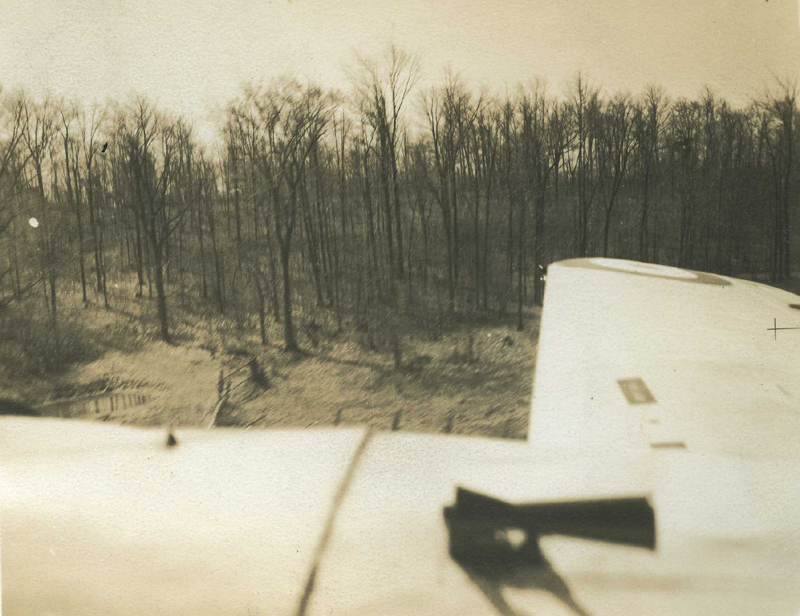
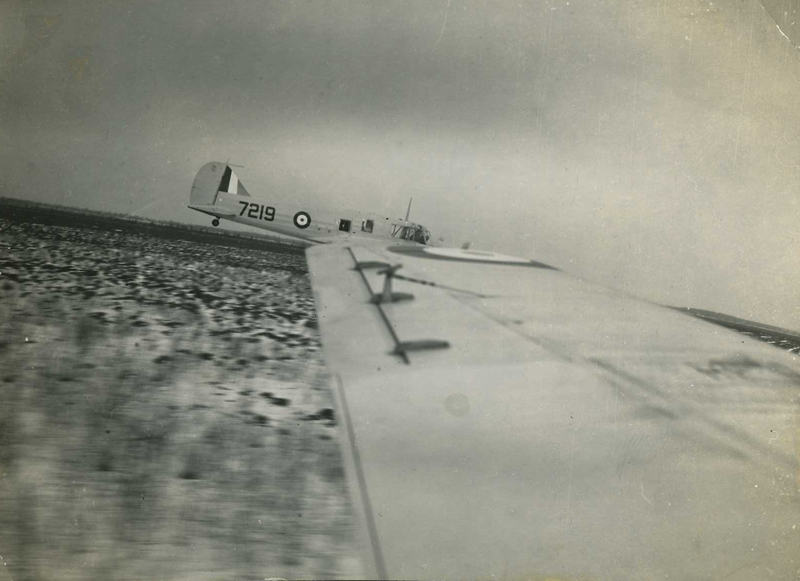
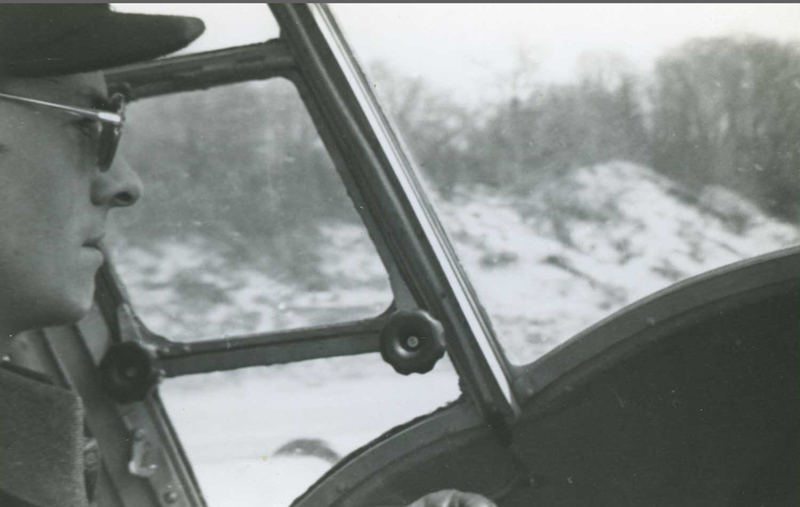
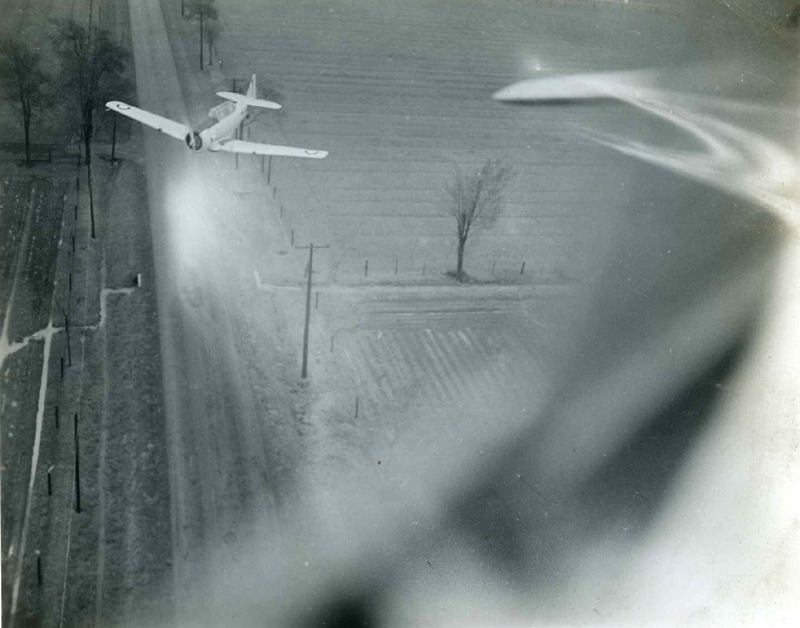
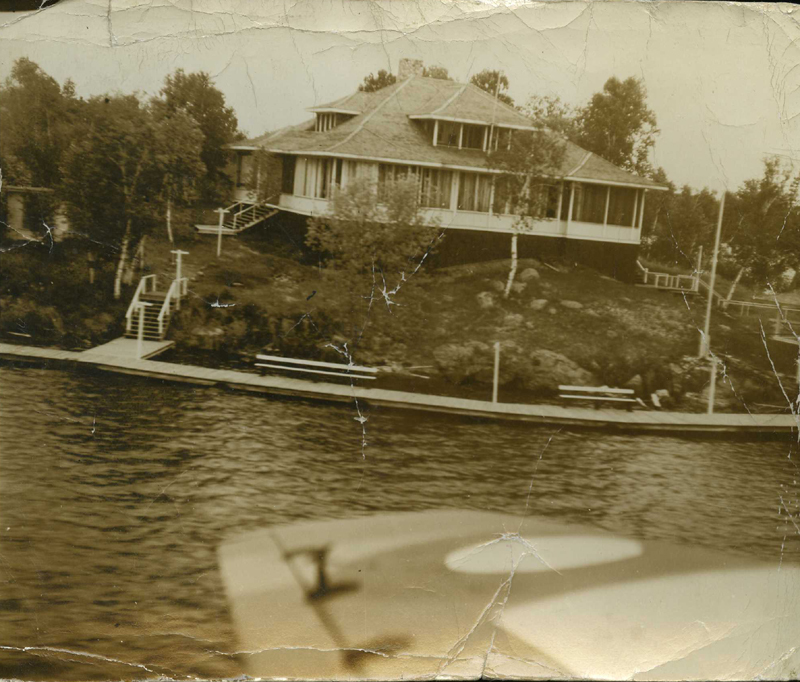
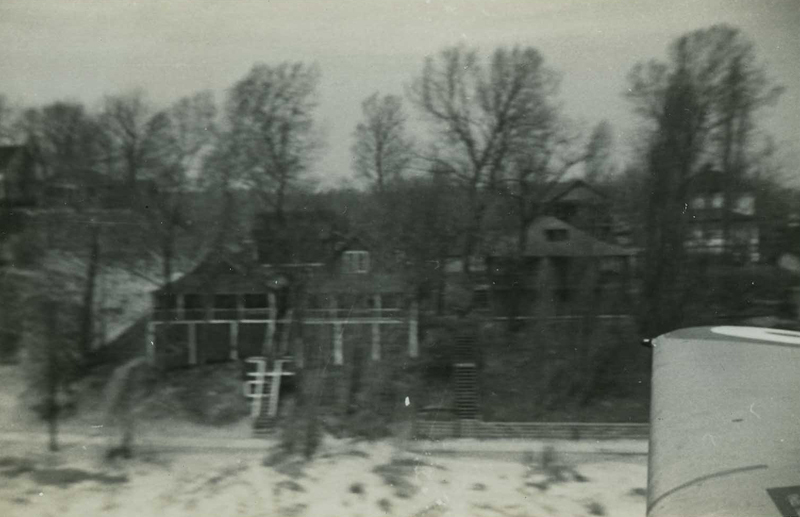
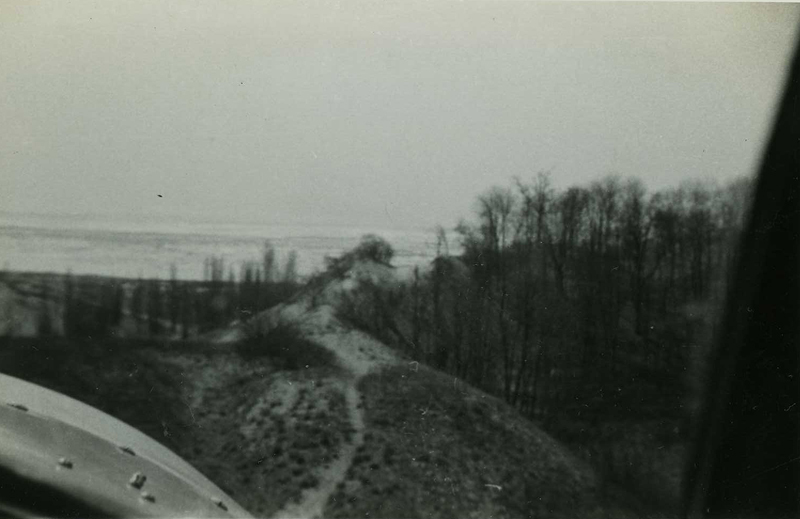
These are all photos taken from or of Trevor's aircraft at various times
Because we were on a peninsular the Yanks had permission to fly from either Detroit to Niagara or visa versa as it was not deemed safe to fly over long stretches of water such as Lake Erie which had a moderately sized aircraft carrier on it for training purposes, so you can gather the size of these lakes.
Now it so happened that I heard the sound of an aircraft in the murk and then out of the haze a Royal Navy Argus high wing monoplane appeared and touched down, then taxied up to the tower to report in. Imagine my surprise when a very small [nearly as small as me] woman pilot showed up and explained that she was ferrying the aircraft to New York but on this leg of her journey only as far as Buffalo. Would I please inform her destination that she was safe but running late?
I told her that in my opinion she should wait for the weather to clear which would not be until tomorrow. Now I had no power to stop her as she was flying for the Americans so I checked her flight plan and said she could proceed but she had to call me to verify that she had arrived and was safe otherwise I would instigate a search as she was flying in Canadian territory. This she promised to do and off she went.
I on the other hand closed the tower down and notified the telephone operator that I was expecting the call and to transfer it to me at the mess and so off to tea I went. Well the good little girl called me right on the time that I had estimated that she should have arrived. I take my hat off to these women ferry pilots cause they did an excellent job both in the USA and UK and she was British too.
Now because of this arrangement we had all sorts of aircraft come across in all sorts of weather and on one occasion there were three P-38 arrived in weather so bad even the cloud base refused to move.
But the Yanks were thankful to have found us and so decided to land. Our field being a training field was in the form of a triangle with two strips on each leg. One for take off and one for landing, so if there was a runway with debris on it from a crashed or disabled aircraft on it the other strip could still be used. At least that was the theory.
Well these Yanks spotted the field and to hell with regulations just let's get in and so they all landed on different runways and all going in different directions. How they missed one another no one knows but it was a great talking point in the mess for some time and to think that most of these pilots had got less hours than most of us here at the navigation flight. Ah well, they had much more men at there finger tips and so could let a few go missing of their own petard.
But on one occasion I had to take the Padre over to our satellite field Welland so he could perform his duties to the men stationed there. As it was still winter [tail end] of course the runways could be treacherous if freezing rain hit them. Well after just a few minutes flying we arrived at Welland and preceded to touch down, and again another Pearce's smooth landing - all three points touching together - but what's this? I'm not stopping! On asking the Padre what his wheel was doing, he replied, “Nothing, it's just stationary,” so I knew we were in trouble as my wheel was also stationary. We were skating on black ice and there was not a darn thing I could do as I was in no position to take off again.
"Just hold onto your hat!" I sang out in my best singing voice as I knew we were going to hit the piled up snow at the end of the strip. With a bang and the tail moving upwards to a fair height and then a sudden downward crack as it returned to earth, I knew we had arrived. Safely I might add, but not a text book landing. Still any landing you can walk away from is good.
Having finished his saving of souls, I then had to fly the Padre home again.
On another trip to Welland [but with the head of security on board this time, for him to check security at the establishment] before we took off I was asked if I would mind putting in the second pilots controls which we always carried and only took a few minutes to connect. I knew what was in the back of his mind, or was it in the front? I don't recall. So off we went to Welland but on the way I was asked so politely would I go down to the low flying area which just so happened to be on our route, and did I mind if he helped to fly the aircraft? Well it was no skin off my nose so yes let's do some low flying and I must admit that he didn't do too bad a job of the flying.
But as we were just about at the end of the authorised low flying area and not wanting to break any Air Force laws I took over and opened up the throttles to climb out, but before doing so I told him to see how close to the telegraph wire I could get. With a gleam in his eyes he acknowledged approval but after passing said wires and starting to climb I had a sneaking suspicion something was not quite right. And I was right, for on looking out my window I discovered that the undercarriage was still down and wire was hanging from it so not wanting to have more problems on landing I left it down
The reason for it to be down was very simple. On the Ansons there was no horn override so it was just a case of lowering the undercarriage till you got down to height rapidly and then raising it again which I had forgotten. So what was I to do? First thing is don't panic so on arrival - thank goodness on the runway facing away from the tower - the security chief asked me to stop the aircraft while he got out so I did just that and a short time later he climbed back in. “Let's go,” was all he said so off to the tower we went and stopped, and as we got out an erk came up to the chief and told him he was wanted on the phone urgently. On his return to my side he informed me that someone, yes someone had had the audacity to low fly and take the telegraph wires out and was he going to give that pilot hell if he could find him. Then turning to the Sergeant in charge he said in all his glory and for everyone to hear, "You had better get someone to remove that wire over on the runway as I had to get out and shift it. We could have wrapped it around the undercarriage or worse the propeller! Disgraceful!”
So another fine mess I've gotten out of easily. Life is progressing at a great rate for on another occasion I was asked to take the paymaster, nursing sister, doctor and one other over to an ITW field flying Menasco Moths [Tiger Moth with a Menasco motor, a canopy and skis]. Now this was a grass field and was rather short for an Anson, but orders is orders so do what you are told. Apparently the men at the base were due for a 'short arm inspection' - ask any Air Force man what that means and they will tell you. A sure way to tell what was going on was when the order came "Women’s division will be paid first then other ranks" and no one escaped this inspection
So on completion of their mission my passengers duly arrived for the ride back to Dunnville. But I am having second thoughts about the take off and the only way that I could see was for the fence to be taken down but as the paymaster had another commitment I decided that yes I could do it but with some help from the doctor.
Now I advised him what I was about to do and that was to sit as close to the far fence take the motors up to full power against the brakes hoping that they would hold then when I had full power release them and get going towards the other fence and try to bounce the aircraft over it. Well things went well as the aircraft got going, very good for an Anson and just before the fence I pulled back on the stick then slammed it forward hitting the ground and bouncing over the fence but then the aircraft decided that it was not quite up to flying speed and started to sink towards [where else?] but the ground.
“Pull the undercarriage lever!" I sang out to the doc which he did with not much more encouragement and I prayed - boy did I pray - that we would not sink any more and yes the faithful Annie answered my prayers and slowly ever so slowly started to climb and so we were safe.
In the evenings sometimes we would go to town to the skating rink or the small canal that ran through the town or just to an LAC Stewart's place where we could spend an evening playing games and just relaxing. Rank did not enter into these activities so it was always a pleasure to go with Pop and also some WAAF’s [Which reminds me LAC Stewart still has my skates that he is looking after for me]. But the most fun was skating down the canal which was only lit by the street lamps on the road way so it was pretty dim on the actual canal.
On one of my first explorations on the canal [you will have guessed that it was frozen of course] I was leading the other participants down towards the bottom and as it was a pleasure to be able to go fast without any corners to worry about I was well and truly on my way until all of a sudden my feet stopped going forward whilst I on the other hand was now spread-eagled face down on the ice sweeping all before me. What on earth happened?! The answer was soon given to me. It appears that when the canal was frozen, the locals to get across to the other side without having to go to a bridge just put wooden planks down which I hadn't noticed and so my skates stopped when they hit the plank but I didn't. Most embarrassing, but was a course of great mirth to the others. I just wonder if I could have got a job in Scotland sweeping the Curling course.
As summer was now rearing its head things were looking good for flying and I was now dressing with a shark's skin jacket, a black ski cap with a set of wings on it and of course my trusty flying gloves, not forgetting my dark glasses just so that I could take a dim view of the goings on around me.
One of the things the RCAF did for the staff, on our station at least, was to let everyone have a flight - whether it be a sightseeing trip or aerobatics everyone could have a flight, so when we in the navigation flight were free we were generally the ones to do the honours and also as two of us were checked out on singles the set up couldn't have been better. As was appropriate each airman or woman received flying pay for a month even though they only flew for a short while which was a big boost to their pay.
So before each flight the person going up for his or her first flight was asked whether they wanted a tiki tour or sheer terror. Well on one of these assignments I had a F/Sgt Wilson wishing to go up for the first time and to do aerobatics. This was on March 28th, 1943, and so explaining to him on what to do in an emergency [such as bailing out] I took him over to a Harvard and made sure he was well buckled in and understood that we were not going up for a joy ride but for some serious flying. He couldn't have been happier by the look on his face and so off we went into the wild blue yonder
Boy was he going to be surprised as so was I, and not by my flying either. Well upon obtaining a couple of thousand feet I then proceeded to go into my routine, first a gentle loop followed by a roll off the top then the start of another loop but just as I poked the nose down there was this almighty bang followed by a rush of air stirring up all the s------ that was in the aircraft and at the same time the lights disappeared and I was now in the twilight of my years or was I! On looking back to my passenger all I saw was a look of astonishment on his face, so he must be alright so what has happened? I can see daylight, not good but daylight there under the dash and to my left and there wrapped around the whole front windscreen including the side screens was a great big piece of metal looking re markedly like a side panel.
What to do, well I am good at side slipping but this time I'll just about have to put the aircraft on its side to see out and of course I do not have radio contact but there was another way of letting the tower know that you were in trouble and that was to switch on your landing light rapidly which was frowned upon for in those days the bulbs had a habit of blowing out quickly but it did alert the tower that you had some sort of trouble.
No worries I just put it on and told the passenger to be a good boy and tell me if he saw any other aircraft coming towards us as I was completely blind. On seeing the light the tower thank goodness did a check on me with their very powerful binoculars and noticed something was wrong so dispatched both the crash wagon and also the meat wagon [ambulance] to meet me.
Boy was I having some fun and all legitimate doing a side slip to the port side [left] all the way down from 1000 ft and at the last minute kicking the aircraft around to do a, and I must say, a perfect three point landing. Naturally I couldn't see to taxi but an erk ran in front and beckoned me to follow him with the aircraft of course.
On inspection it was discovered that of the four lugs [could have been more] holding the panel to the aircraft these were if I remember right called Dzus fasteners*, three of them had not been fastened properly and so with the force of the wind, the panel parted company. Needless to say the poor erk who had last fastened the panel was in for the high jump of Air Force discipline.
Checking the passenger I found that he had thought that this had been set up for his benefit and was duly surprised to find that it wasn't. Still he did get some air time and was not put off by the experience.
On one such flight I was asked to take a WAAF up for aerobatics, and was she small? So having made sure she knew what to do in an emergency and was firmly strapped in off we went and having climbed to a safe height I proceeded to go into my act. At the end of each exercise, I always checked that the passenger was alright and so could continue, and on this occasion I checked at the end of the first loop but on looking in the mirror all I could see was a dainty pair of hands gripping the dash and then a face appeared laughing at me.
“Are you alright?” I asked and she just nodded at me so I continued and each time was the same just a pair of hands and then a face laughing. I can't have this so made the aircraft do things that were not on the books but each time the same results occurred.
So after half an hour I went in for a landing and on walking back to the hangar and talking to her and she was still laughing. Most frustrating. However who should be in the hangar but the CFI [Chief Flying Instructor] who asked me the score, so I told him that nothing that I did could upset her. Well the CFI was apparently no slug on aerobatics so asked her if she would like another ride. She nodded her head and gave him a great big smile so without any more ado he told her to get into his aircraft, then asked the tower to suspend all flying in the immediate area while he showed off his skills in front of the whole station. You knew which aircraft was his as he had had a large flag painted on both sides of it which made for easy identification to us navigation boys.
This was going to be good. Well away he went and made his aircraft do things that no sane person would have done. Boy was he good and so on landing everyone crowded his aircraft to see a subdued airwoman but instead out she came still laughing, and the CFI, well he came out looking a little white and just shaking his head. So WAAF's 1 CFI humbled and in front of the station too, so I felt rather good about my flying.
I was also privileged to take up a F/L Colin Gray who was on R&R from flying in Britain. He was an ex-Battle of Britain pilot so I felt honored to take him on a tour of the territory. He sat in the second pilots seat and no the dual were not in operation. As a person he was most unassuming to say the least, a perfect gentleman in the true sense of the word.
On another occasion I was landed with a Wing Commander and two other high ranking officers [I am not a snob, I'll take anyone]. They wanted to see Niagara Falls and the Welland Canal so with the other bods in their seats the Wingco sat down in the 2nd pilot's seat and we started out on our tour
Now a small problem with the Anson is that GEORGE [the auto pilot] was not at home [holidays I believe!] so all trimming had to be done by yours truly, me and the trimming crank was on the right hand side of the throttle console and me being of short stature I had to lean well over each time a change was required thus loosing sight forward so I used to take pride in being able to trim the aircraft to fly hands off. But I was to get a rude awakening on this trip for as each point of interest came along the Wingco got up and walked to the rear of the aircraft to point out the scene and then would come on back again explaining everything to the two officers so each time he moved I would have to trim and so the more he moved the more I trimmed. Now certain pilots, me definitely could stand this shenanigans for just so long before exploding.
“Sir sit down, buckle yourself up and stay put because you are upsetting the trim of this aircraft as well as upsetting me.' He promptly sat down and I had no more trouble with him and we proceeded on the tour and then returned to base. On parking up the passengers disembarked while I was busy shutting down and on completion I headed for the door. Imagine my surprise when on looking out there in all his glory with his hat on stood the Wingco. "Oh, Oh" I thought "here is where I get a telling off" but as I jumped out onto the ground he drew himself up to attention and threw me a salute to which I could not return as I was not wearing a hat. Protocol demanded that I must have one on to acknowledge same.
“I am terribly sorry for the trouble I caused you, I should have known better. You were quite right in telling me off I congratulate you." And with that he turned to join his guests. It just goes to show that there are still some higher ranking officers who were not too up themselves to admit mistakes.
On May the 6th I was instructed to take line photos of the Welland Canal just so the powers that be could form some idea of what they could do if the canal was damaged by enemy action. This seemed rather pointless as we were not equipped for aerial photography but with some ingenuity a plan was worked out to get the photos. Now with the photographer aboard I had him stationed at one of the rear windows and aiming the camera obliquely I figured that we would get the shots we required. Now this required me to fly from Welland to Port Colburne at a constant speed and height while the camera was being used. Each photo had to overlap and the date was also shown on the photos
Well things went well and the exercise was completed so as there was some film left I decided that as there was approx 34 ships stuck in the ice and trying to get to the canal this would be good for a captive audience to be filmed at where else but low down.
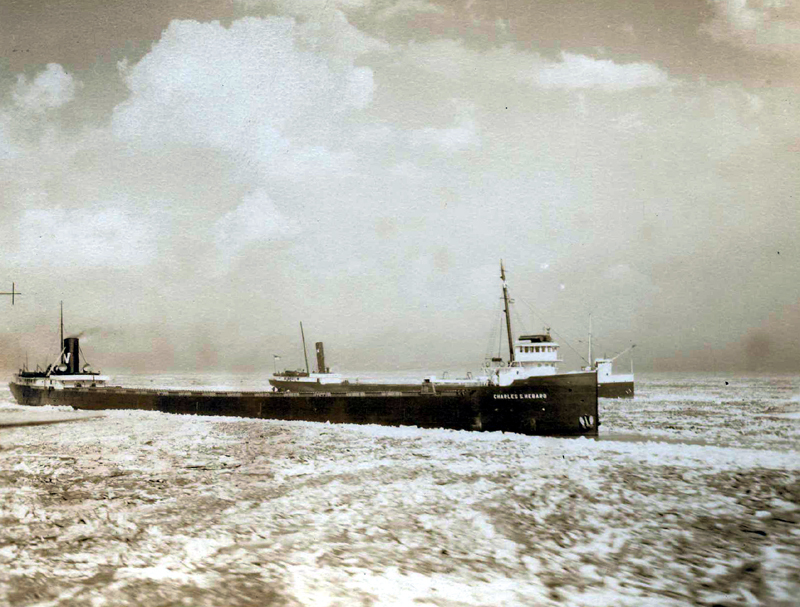
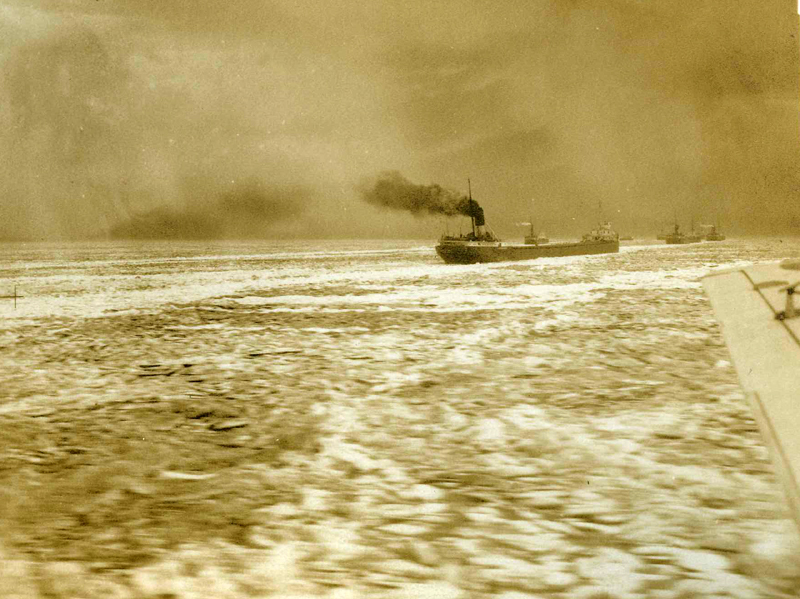
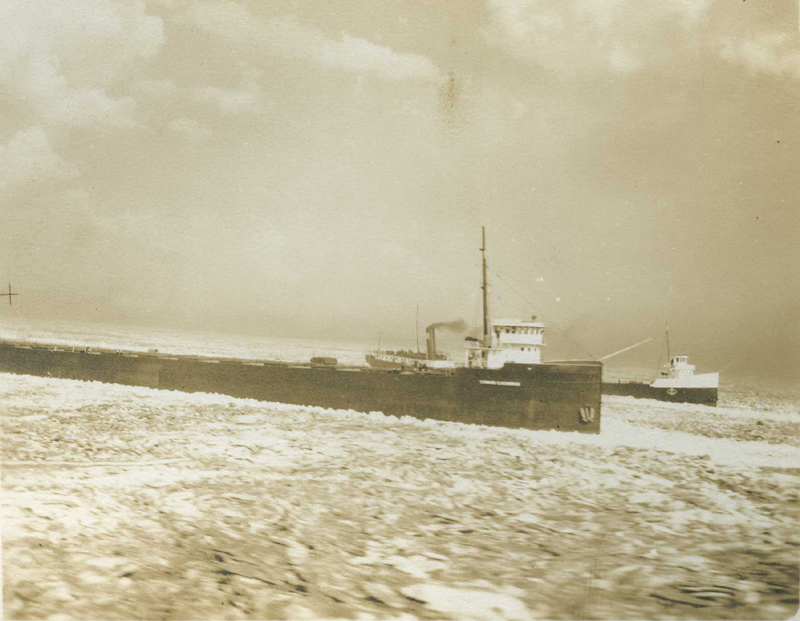
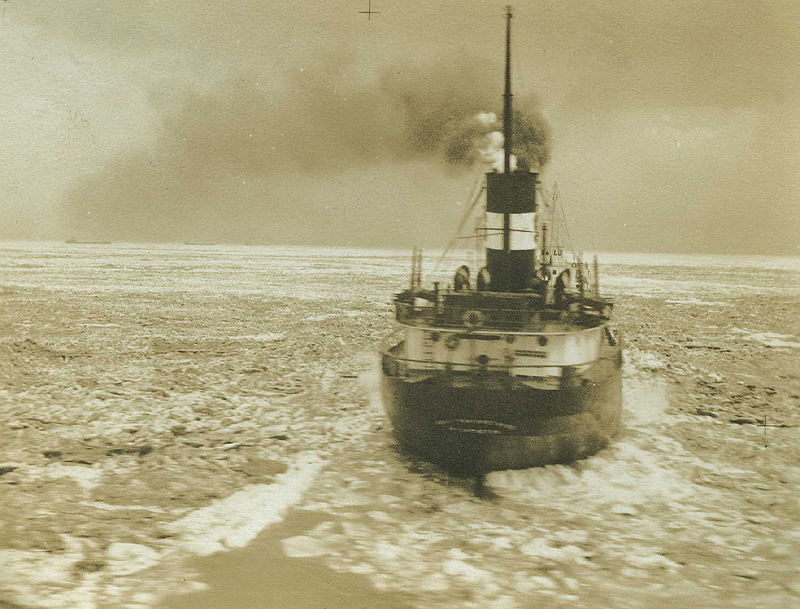
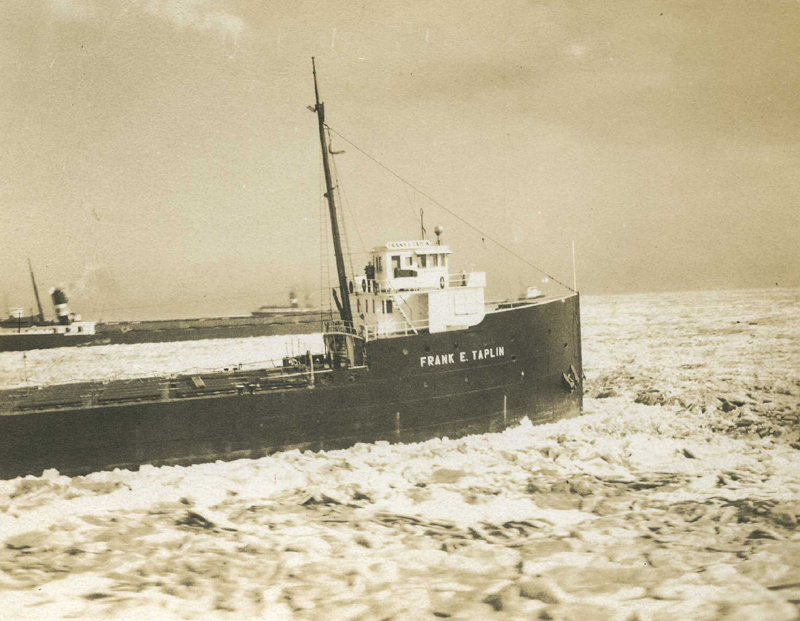
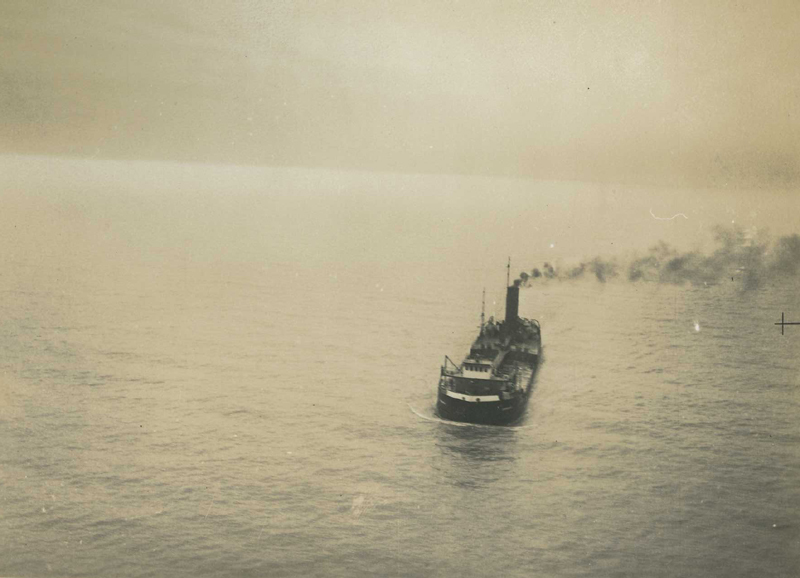
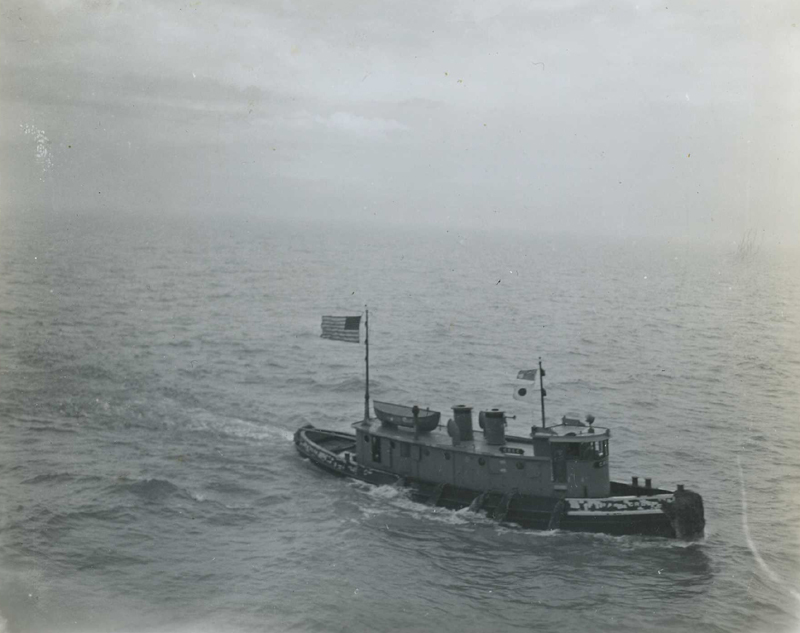
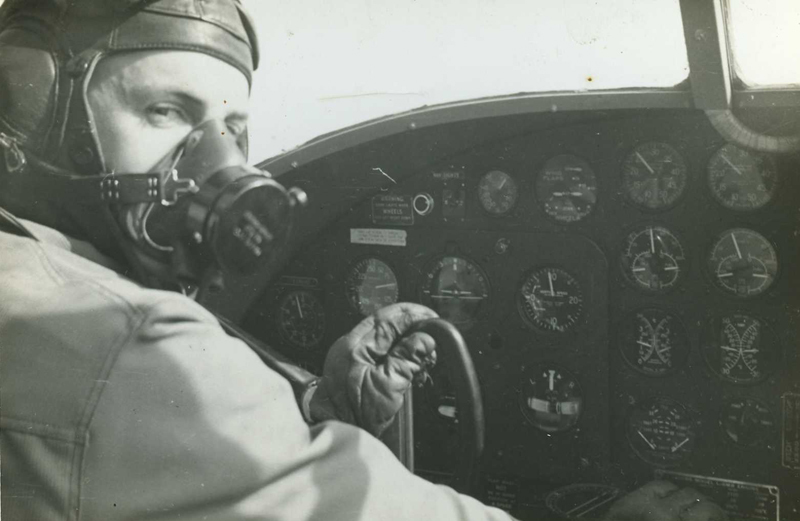
So down we went flying amongst the ships, flying so low that we took their pictures looking up just look at the photos, and remember these were not small ships as some were over 10.000 tons. Well a good time must come to an end when the photographer said that a really good photo would be one taken between the mast of a ship.
BETWEEN THE MAST OF A SHIP he must think that I am crazy to do that. Hells bells I could do months in the cooler if caught.
But what the hell, I see a ship plenty wide enough so I told the photographer to get in position and when I sang out just click the bloody camera [if we hadn't crashed that is] and lets get to hell out of there. So we approached the ship at low very low level and I sang out now and with a hoot and a holler we were not there anymore as the old Anson was really wound up to get home and away from the scene.
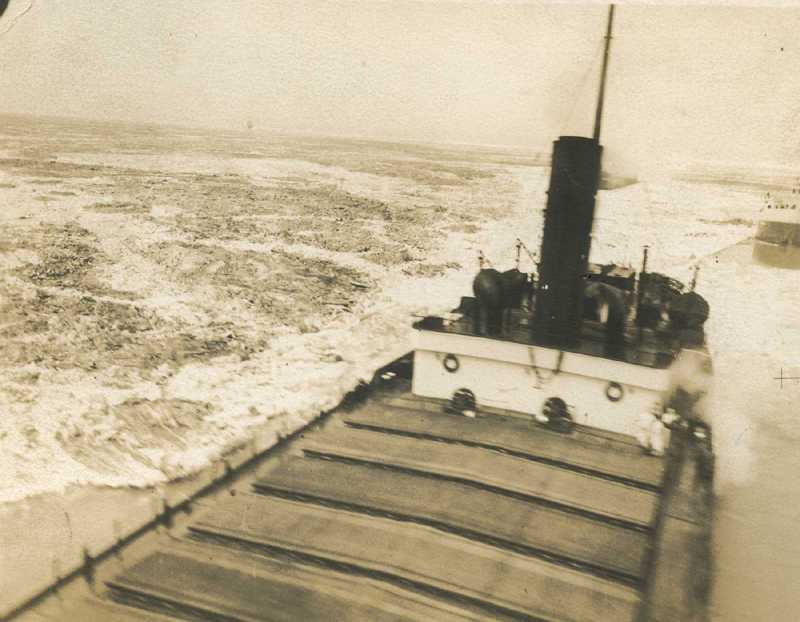
It's true, look how low this is as Trevor guides the Anson between the aerial
masts of this ship. One mast can be seen - the aerial wire was above the aeroplane!So on arrival at the station I parked up while the films were rushed to the dark room to be developed. Things looked good as the film [one continuous strip] was hung, not in the room but out in the hall way. While both the photographer and myself were admiring the results there appeared at the top of the stairs no other than the CO. Oh, Oh, Trouble. But too late to do anything now.
“OH are these the photos of the Canal?" he asked as he slowly, ever so slowly ambled along the negatives inspecting each and every one. With about six more to go before the incriminating pictures would come into his hands he stopped and said,
“As soon as you have the proofs bring them to my office. They look pretty good, don't they?” and with that he turned and went down the stairs and over to his office.
Quickly grabbing a pair of scissors the Sgt cut the negatives at the start of the offending photos and quickly took them into the dark room. When he had printed these he then gave me the stills and quickly destroyed the negatives. I of course still have the prints in pride of place [my album].
On examination of the photo taken between the masts one can see four of the crew on the deck with the bridge higher than me. This is one of my most treasured photos.
I just do not know why my number was not taken and given to the authorities, still I was in American waters.
Now if you think that all we did all day was to fool around let me give you a rundown of just one day in the life of a working staff pilot. First a trip with students in the morning lasting two and a half to three hours. Then after lunch a couple of a/e [aircraft and engine tests].
Then one or two night flying tests, getting the aircraft that were to be used that night ready. Then after tea a two and a half to three hour exercise with trainees, and if one was to have the misfortune of arriving back and finding that there was still one or two trainees still waiting to go up, so it was your misfortune to head out again. But this time the pilot [me] got handed a lunch pail, American style, so as to partake a snack on the journey. It was quite unique setting out the thermos flask on the window shelf and having a sandwich and cake with a banana thrown in also. The trainees on the other hand got nothing.
The good thing about this was that next day I was not required to report for flying until the afternoon so could get a sleep in but of course no breakfast in bed. These hours totalled up to eleven and a half hours and these were not isolated cases . So you can see it took a toll on ones stamina as we were also required to keep up the Link trainer and also P.T. So you can see things were not all beer and skittles
Now you know why we had to let off steam now and again. This of course led to some interesting situations, especially if you had been given an assignment that would allow you to beat the hell out of something and all legitimate. This happened one day when both Pop and myself were called into the flight commanders office and told to go out to a particular spot and see if we could locate and theoretically destroy an army convoy traveling in the area and we were to try and catch them by surprise.
This was to be a combined exercise with the army so “good luck you two." So without any more ado, both Pop and myself set off to the position given, he flying on my port side [left] and reasonably low down when Pop waggled his wings to signify that he had spotted the convoy. Now there existed between Pop and myself a sort of sixth sense in what we would do. Pop signaled that he would attack from the front while I was to come in from the rear.
Off we went low, low down after all we were told to surprise them and so I swept in from the rear with the convoy on my port [left] side while Pop came in from his port side and theoretically we blasted the hell out of the army as they did not have time to get out of their trucks and fire at us, so we claimed total annihilation of them. On arriving back at the field both Pop and myself were ecstatic as we had done some pretty low, low flying.
On reporting to the flight commander he congratulated us on a job well done and read for us a message from the head of the army saying that the attack was so well planned but did we have to take the telegraph wires down as well? Well I know that I didn't touch them and Pop shook his head also so it must have been Kilroy that did it. Still it was a very exciting exercise.
This of course was not the only flying Pop and I did together as when winter was on us just for shear hell and boredom we often flew together, in different aircraft of course, looking for mischief and we usually found it. On numerous occasions we would find a small lake with fishermen on it in their little out houses. Now these out houses consisted of, for those who can remember them, what looked like a toilet called a long drop that used to be on the farms and elsewhere, only slightly bigger for also inside was a stove and usually a small table plus hooks for hanging up coats etc. In the center a large hole was dug threw the ice so the person inside could fish. Yes, they were for fishing. Now you can imagine half a dozen or more of these in the center of the little lakes and so they were fair game for what we were about to let loose on them.
On spotting these, whoever was in front would skim - and I mean skim - the ice at the lowest level one could go flying between the sheds, and of course the people inside invariably came out in a hurry to see what was going on but of course they always seemed to look at the aircraft that had gone past when low and behold another blasted aircraft suddenly appeared heading straight for them. Well if you have never seen men attempting to get traction on ice in heavy boots and coats with an aircraft chasing them well you just have to use your imagination as the results, to us doing the flying it was just quite hilarious. And of course there was so much bedlam that they never took our numbers and remember that mobile telephones didn't exist then I suppose you could today call us bloody boy
racers or yuppies.
Well as all work and no play makes Jack a dull boy, it was with some reluctance that when a 48 pass [two day pass] was issued to you, you were loathe to take it or else you were joking as they were worth there weight in gold, if we had any gold that is. So when a 48 was offered you took it rapidly and disappeared somewhere away far away from the station. On one occasion when I was due for one I decided to go down to, of all places, NEW YORK. So off to Hamilton I went to catch the train from Toronto to New York. Now even though we were allies of the USA for some reason we had to have what was called a Short “H” pass and without it no way could you get across the border. Funnily enough it was on the Canadian side that all the trouble occurred.
Now as we were getting close to the border those dreaded words “All Tickets Please” this was from the border control and of course I did not have the correct document. So the conductor told me that I would have to get off at the next station, Niagara Falls. Oh well it was worth a try. As I was about to get off the border controller said, “If you go to the main road by the station you may be able to pick up a ride to the bridge and who knows you might be able to talk someone into letting you cross.” Enough said. Off I went to the road and flagged a small pickup down. The driver was an American and for some reason had to come over his side of the border so he would gladly take me to Buffalo {in the USA}. But wait I don't have a pass I told him and he just grinned and said nothing.
Off we went to the bridge across the falls linking the USA with Canada and as we approached the border control I thought that this is it but no the border guard just waved us through and we were in the States.“
"I do this trip every day and they know me pretty well and know that I wouldn't do any thing illegal." A man after my own heart no doubt.
“So I suppose you want to catch the train?"
Would I what, and with that he took me to the Union Station and dropped me off. On climbing aboard I sat in the same seat that I had not long before vacated. Now we were off to New York and then the same border officer came through and asked for tickets again.
“I see you made it alright, “ was all he said and with a big grin on his face too. Now all I had to do was sit back and await our arrival in the Big Smoke.
As I only had a 48 hr pass, boy was I going to have to put one hell of a lot into the time at my disposal. So all the usual places of interest was looked at. Central Park complete with the Zoo - and before someone says that there is no zoo, let me assure you that in my time 1943 there was as photos will show it. I also took in the famous Coney Island, went up the Empire State building and what a sight that was, rode the subway, saw Grants tomb and went to the Stage Door Canteen. You know, the canteen where only service men were allowed and because I was unusual in that I was a foreigner and dressed different to the others I was never short of partners and they were all young up and coming actresses
While there I also had the pleasure of listening to Jimmy Dorsey {not Tommy Dorsey who was also in NY at the same time}. Of course you just had to see the Statue Of Liberty even though were not permitted to land but the ferry ride was just as good .a place to view the famed statue.
While in the Big Apple I met a Miss NOLA LUXFORD a New Zealander who would take the kiwis to the Radio City and make recorded messages to send back to the families back home and there were plenty of Kiwis in the city for her to round up.
But of course time marches on and all too soon time was up and I was forced reluctantly to return to the camp. Yes my family did hear my message and they were thrilled to hear my voice again even though I could not give them any hint of what I was doing or likely to do.
Again while in the Big Apple, I was treated with great respect by everyone and of course the famous cabbies - some of whom turned their metres off just to show their hospitality. But back to the daily grind of reality. One of the things that amazed me was all the talk about Coney Island and their famous roller coaster. In Canada just 30 odd miles away from our station was Crystal Beach which boasted a roller coaster and which I only found out just recently that it was the tallest and best in the North Americas. I have a photo of it but of very poor quality as it was taken whist flying per my trusty Argus. Did I ride on it? Heck yes and I will admit reluctantly that I was never so scared in all my life even though I rode on it in all different positions. Now as the Welland Canal was between Crystal Beach and Dunnville, I just had to have a look at the goings on at the locks.
At the Panama Canal the ship going through the locks were controlled by four what were called donkeys or mechanical mules and amid whistles and bells clanking, they kept the ship in full control. However at the Welland Canal there was only a chain ahead of the lock gates and woe betide the captain of the ship if he was to so much as breath on it as he was in for one very hefty fine.
The number of ships going through the Welland was enormous as they were lining up both ways to get through and all they used was a pilot [not a flying type] and not a tug in sight.
On another occasion I was in the low flying area with my tried and faithful Annie and on one side of the field where we were not supposed to stray was a tram line going from Welland to Port Colburn, and which interurban trams ran. And it was very unusual to manage to find one travelling on the line just as you got there so I was more than happy to do a beat up on the offending tram. So with my wing over the line and under the overhead trolley line I proceeded to fly towards the tram while the Driver just brought his tram to a stop and jumped out of the tram and ran away from the, as he thought, point of impact and to hell with the passengers who must have wondered what was happening.
But no I had no intention of hitting it so pulled away and continued my low flying. After all if my number had been taken then I could always claim that someone must have shifted the lines overnight.
Well I can dream can't I? But again I was lucky as there was no report handed in.
It was mid Summer time when a very serious event happened, not to me but it involved a student pilot flying a Harvard. Now on Lake Erie was a steamer that used to ply between Buffalo [Niagara Falls] U.S.A. and a place called Crystal beach, just between the Welland Canal and the falls.
Crystal BeachThis beach was a very popular beach for tourists as it had at that time the highest and the most scariest big dipper or roller coaster if you prefer in all the Americas and Canada. So it was very popular with the Yanks and also the Canadians and us at Dunnville being so close it was a place to go and have some fun.
Now this ferry which was called CANADIANA.
After it dropped off its Yankee passengers would then proceed to take on passengers from Canada and take them on a joy ride just along the shore line for a few miles and then return to crystal beach. In other words, a Tiki tour.
Well on one of these trips whilst plying between the Welland Canal and points south a young trainee pilot from Dunnville saw the ferry and proceeded to have some fun and he proceeded to beat the HELL out of it and I do mean beat the hell out of it. On board were some Officers and also some pregnant women. Now the captain of the ferry was starting to get very worried as this young pilot was coming dangerously close to the ship and so the captain prudently stopped the ship and made contact with the authorities.
All the while the Officers on board were waving at the pilot and pointing to their rank but either he thought that they were encouraging him or he just didn't give a damn as he just kept up his "attacks" and on one of his passes parallel to the ship he opened his canopy and flew by saluting the officers - his wingtip virtually scraping the side of the boat - causing some of the pregnant ladies to faint. Well on one of his runs he headed straight for the boat pulling up just at the last moment when at the top of his pull up he did what is called a high speed stall and then a flick roll [the aircraft's doing not the pilots] and then he promptly plunged into the lake thankfully missing the boat, killing him of course. It was a good thing that he did as back at the station [Dunnville] awaiting him was a military guard of honour waiting to accompany him to the guard house to await his fate which of course had already been decided.
I, along with the other staff pilots and also the instructors, had the dubious honour of inspecting the aircraft when it was removed from the lake and brought to one of the hangars. To see the imprint of the pilots head along with surprisingly a large amount of blood even though the aircraft had been under water deeply imprinted in the instrument panel was a very sobering thought. But of course this just goes to show one what can go wrong when one steps over the bounds of safe flying. Of course his lack of knowledge of his aircraft and flying ability was a very large contributing factor.
Now as the temperature was heating up it was time for some serious low flying. If in an Anson I would fly to one of the numerous beaches put my wheels down till they touched the beach then retract them as I now knew that was the height I could fly at.
However if in a Harvard I just had to guess how low to go and thankfully never made a mistake. On one such foray I together with a pilot called Cook in another aircraft, or best known as Cookie, was doing some low flying when into view a tug towing a loaded barge appeared and being American was fair game.
Standing on the stern of the barge was a lone seaman so it would be fun to make him jump into the water and so we attacked him in turn but despite all our efforts and some hectic low flying he was not to be moved. At least I got a photo of him just standing defiant.
Now one of the scariest moments of my flying career was when I struck a white out. I had flown up through the clouds and came out on, as I thought, was the top as the cloud was now below me but then I noticed the cloud above me and it just seemed to join the bottom layer no matter where I looked and trying to fly by the seat of your pants was not an option either so it was back to instrument flying and a problem was now manifesting itself as how does one get down. Knowing the area well I decided to head out over the lake hoping that I would clear the base before the water came into the cockpit and if that happened I would know that I was too low. So sticking to the instruments I continued my decent and at about 500ft I cleared the cloud base over the lake and so was once more safe. It was not a position that I would advise any one to get into.
Well the long hours were beginning to tell on me and on one of my straight and level flying between Welland and home base and in an Harvard I next remember vaguely that the aircraft seemed to be spinning and my vision was blacked out, so I automatically started to correct the spin and when the motor roar seemed to steady out I can just remember gently pulling on the stick and feeling my backside being pushed into the seat and I knew that I was at least right way up. At that time my vision started to go gray and then I had full vision and yes I was climbing but horrors of horrors I was only about 500ft above the ground so pulling myself together I flew sedately back to base and on landing went straight over to the doc to report what had happened and was promptly grounded, much to my disgust. That was on the 28th June 1943
So it was a case of wait for the doc's decision. Of course this did not exonerate me from working and my services were used in the control tower and on off days I would cadge a ride just for the hell of it and it was in this period that my faithful aircraft '7302' met her demise. Now when a pilot went sick or on extended leave his aircraft was returned to what was called the pool and so everyone was permitted to fly it if for some reason their one was in for maintenance.
Now Pop had a mission to perform and that was to fly with the doctor down to Toronto and pick up a patient and return with him back to Dunnville. All went well until the return trip when, without guessing, yes a motor failed and so Pop knew he had to land as he was just too far away from a field, [airfield that is], to make a landing so elected to land in a ploughed field and on approach lowered his wheels and flaps but realized that he would overshoot so decided to go over the railway line but under the telegraph wires.
All was going well but his wheels hit the small embankment on which the railway lines went and this in turn pushed him upwards into the wires which had unfortunately a very heavy wire cable supporting the poles which proceeded to cut into the base of the windscreen and then carried on cutting and destroying the aircraft. The doc had rolled onto his side and the wire hit the control column which was extremely thick and strong slamming the wheel onto Pops chest and thankfully bending the back of the seat: allowing Pop to fall back but still attached to the aircraft by his seat belt.
This in turn allowed the cable to carry on in its own destructive way to slide up Pops chest and catch his throat cutting it severely open while at the same time sliding up the docs side breaking his ribs and badly grazing his right arm which had been flung above his head. The cable then continued on down the length of the aircraft across the wireless operators table and gently dropping into the patients lap and there it stopped. On extricating themselves the doc immediately went to the first aid section of the aircraft and opened both up and staring him in the face was total emptiness. Some one had removed the contents of both containers. Well the Doc was not going to give up on Pop and he stood there against the side of the aircraft holding Pops throat together and singing out that, “You are not going to die on me you son of a *****” and if you look closely at the photo you will see the remains of the aircraft also the opened containers and also Pops blood on the side of the aircraft.
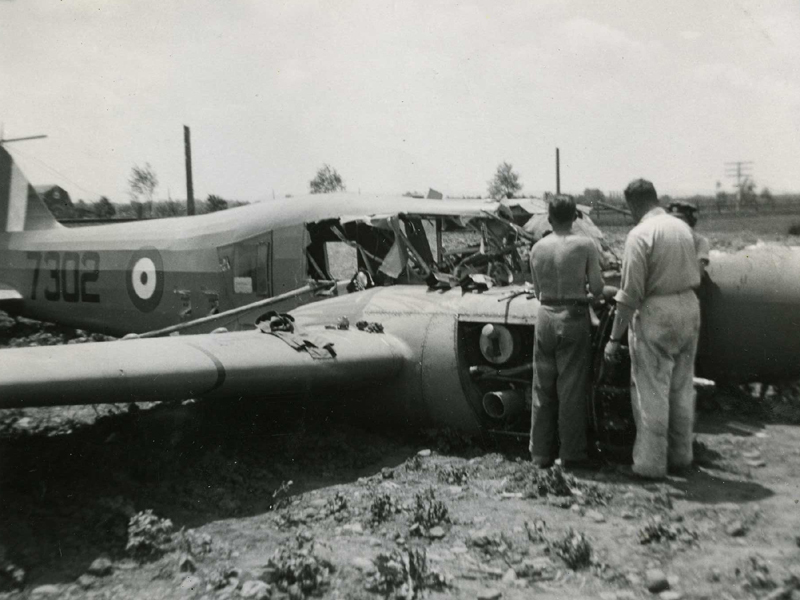
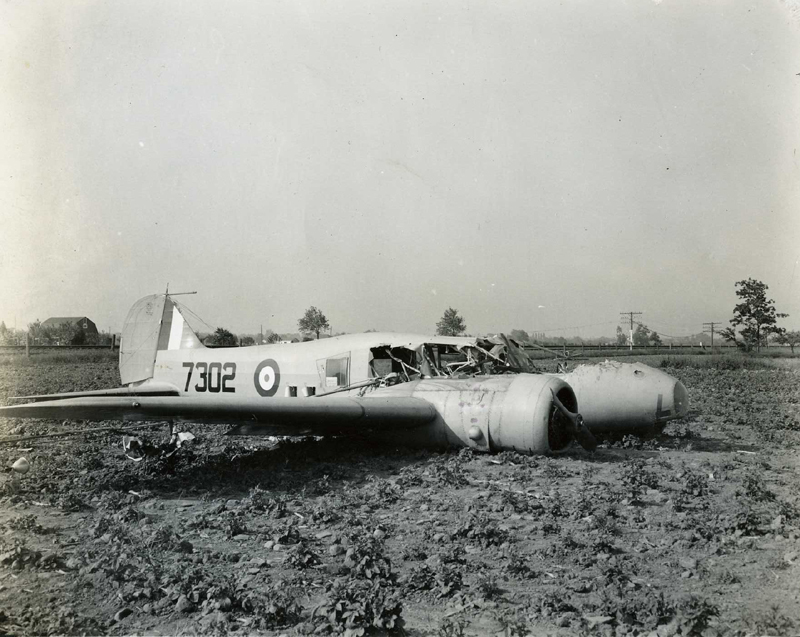
Did Pop live?
Well yes he did and he married a very nice Canadian W.A.A.F girl later on. As for the doc he recovered but the patient was a proper cot case and in fact I believe that he had to be discharged from the Air Force because of the trauma the accident had on him. As you will remember that he was already a patient when he was picked up. So it seems that inanimate objects do have feelings as why did an aircraft that have a reputation as a rogue aircraft and did as you will remember played up on the first time I rode in her but then gave me at least ten months of sterling service, but on being put back into the pool decided to start her roguish ways again and it was unfortunate that Pop was on the receiving end of things. I suppose that at least I had had a good rapore with it while I had it as it gave me sterling service. So where ever you are old girl I salute you for the service you gave me and for making me feel that I could do anything with you and you would pull me through safely.
And so another chapter was finished as by now I had received my marching orders and was to report to Ottawa on the 14/7/43.
______________________________________________________________
Note 1 - The Dzus fastener (pronounced zuss) is common on aircraft even today and is a quick release fastener for panels which are fitted basically by pushing the fatener into a hole and performing a half turn. If not turned all the way, they can work undone through vibration, as is most likely the case here.
Note 2 - WAAF stood for Womens Auxiliary Air Force, and was a seperate service made up of women performing many of the same trades that men did in the RNZAF or RCAF, etc.
Note 3 - See more on Nola Luxford here
Note 4 - See more of Welland Canal here
Note 5 - See more on Crystal Beach here

